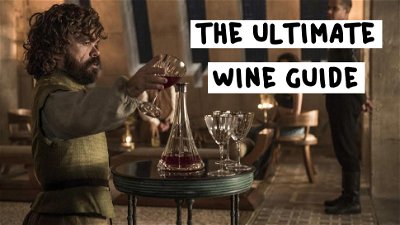
The Ultimate Wine Guide: Everything You Need to Know!
WELCOME TO WINE
Aside from beer, it's hard to make an argument for a more iconic alcoholic drink than wine. Not only has wine been an integral part of human history for thousands of years, it also offers an endless variety of flavors, colors, and other sensorial delights to anybody who dares to drink it — y'know, like tragic Greek heroes or your friend Karen from work who's "only going to have one glass" at dinner. But even though you've probably had at least a few bottles of wine in your life — or maybe this week — how much do you really know about the ethanol-infused nectar of the Gods fermented from grape juice? https://giphy.com/embed/3rgXBLaXy6X72X9fGM If the answer to that question is anything but "I know everything, I'm great, kiss my grapes," then you're going to want to take at least a little while to peruse the following Ultimate Wine Guide. In this brief yet comprehensive breakdown of wine we'll be covering everything from how wine is made to how to identify different types of wine to how to drink wine like a true connoisseur. We're going to learn where and when wine was first made, how it's evolved over time, and how it's going to change heading into the future. After you're done with this wine guide, you'll not only be able to demonstrate your wine knowledge for all of your friends and family, you'll also be able to stun any run-of-the-mill sommelier. And if you don't know what a sommelier is, don't worry, we're going to cover that too. So sit back, grab yourself a nice glass of merlot and prepare to learn everything you'll ever need to know about wine. https://giphy.com/embed/9o7dXamNwWq08WHAT IS WINE?
First things first: What is wine exactly? According to the almighty Wikipedia, "Wine is an alcoholic beverage made from fermented grapes." And that's all there is to it, case closed, that's the beginning and end of the story of wine, move on budding home bartenders, nothing to see here! Err wait. Even though wine has a super-simple definition, it's still an extraordinarily complex category of alcohol that encompasses countless varietals, an endless number of terroirs (areas where a given wine was produced), and, of course, a gargantuan lexicon full of terms that are just as useful as they are highfalutin. https://giphy.com/embed/BXdqYjI3CTRCM In terms of the broad strokes of how wine is made, that does indeed basically boil down to picking a bunch of grapes — specifically wine grapes, not just any ol' table grapes — smashing them up to release their juices, fermenting the juices with yeast in order to achieve a liquid infused with ethanol (something on the order of 5-15% alcohol by volume), aging the fermented boozy juice in barrels for at least a couple of years (and often times much much longer), and bottling it before it can be sent off be drunk by you and Karen and whoever else is just trying to get through the dang work week. And while there are other steps that are often involved in the wine production process, including blending and filtration, as far as the very broad strokes of how wine is made, those just about cover it. The history of wine, like everything else wine-related, is extensive and complicated, and not only intertwined with human history since the dawn of civilization, but also proof that if something is both delicious and boozy, it'll spread across the world from country to country, culture to culture. We'll save the more specific details of wine's history for the following A Very Brief Wine History section, but as far as the super basic points to know should you be cornered at a party or bar and forced to demonstrate your mad vino mastery, they are as follows: According to most sources, wine was first discovered in China about 9,000 years ago. For reference, organized agriculture (farming) is thought to have developed anywhere from 10,000 to 13,000 years ago. After grape wine was discovered in China, it then basically leapt from continent to continent across millennia as one major cultural powerhouse after another discovered it and fell in love. https://giphy.com/embed/l0Iy3FV0TB1A343Ys Ancient Armenians developed the first (extremely primitive) wineries, ancient Egyptians helped to spread wine throughout the Mediterranean, ancient Greeks anthropomorphized and worshipped wine, and ancient Romans helped to refine the wine production process and turn it into a real business. Basically, if there was a significant ancient civilization, it was, without fail, interested in making, drinking, and trading wine. Jumping ahead a few millennia, wine continued to spread like wildfire, leaping across the Atlantic to the New World thanks to Spanish conquistadors. Once it made the leap, wine spread across North America and South America, eventually enveloping the entire world with its righteous bouquet of flavors — and yeah, its alcohol content. Leaping forward to contemporary times, we see that wine is still a massive economic pillar of the global community. The worldwide wine market is expected to be worth $424 billion per year by 2023, with wines being sourced from over 10,000 varieties from 72 different countries (and those are just the top producing countries...). Wine also continues to be inexorably linked to the development of human civilization, and will likely be far into the future barring any catastrophic impacts to the planet's ability to support thriving vineyards. Which sounds like it shouldn't be an issue, but thanks to major climate change, it may well be. But we'll get into all of that in the Future of Wine section below. For now, let's start with where wine comes from rather than where it's going with a snapshot of wine's journey from accidental ancient Chinese discovery to super-popular drink sipped from glasses around the world. Or plastic cups or whatever, we don't judge.A VERY BRIEF WINE HISTORY
Alright, now that we know the broad strokes regarding what wine is and where it came from, let's take a closer look at its history so we can better understand the evolution of grape juice-derived booze. As mentioned in the previous section, wine has been intertwined with civilization since ancient times, and it seems that over the millennia it's only become more and more (and more!) popular.FIRST DISCOVERY IN CHINA
As mentioned previously, wine was, according to researchers, likely first discovered in China around 7,000 BC. It's hard to say exactly how the discovery first took place — perhaps it's even impossible to ever know with complete certainty — but it seems reasonable to assume that it came about thanks to people's lives transforming from hunter gatherer focused to agriculture focused.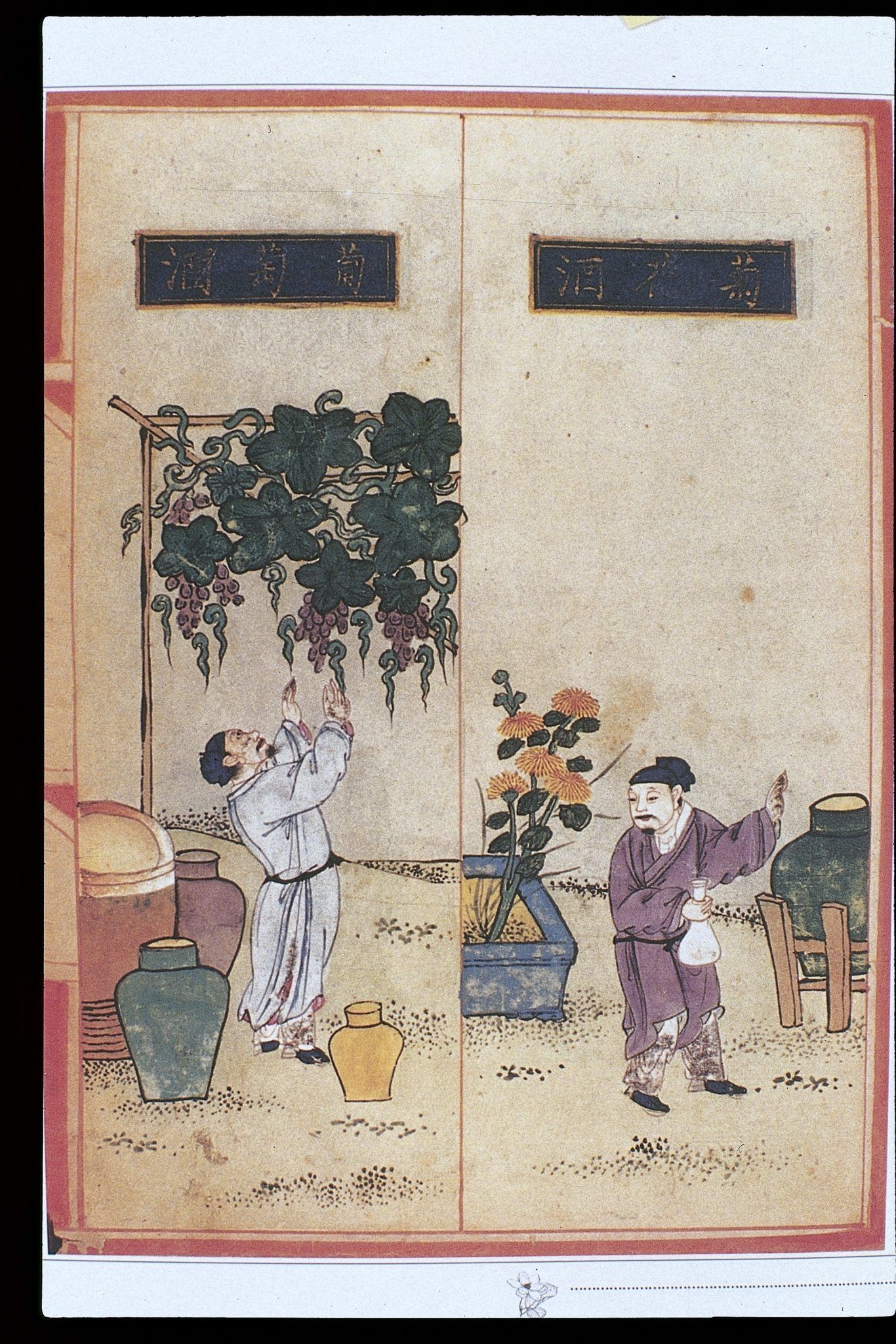 Depiction of cultivation of grapes and winemaking in Ming Dynasty China. Image: Wikimedia / Creative Commons
See, people have always been about picking them berries off of trees and eating them, but it wasn't until primitive peoples began staying in one location that the berries were able to sit in baskets (or other receptacles) for long periods of time where they could grow old, disintegrate into juice, and eventually self-ferment. This is how researchers believe wine was first discovered — by a total fluke due to the fact that people were just chilling in one spot for long enough to let it happen. Which goes to show you that good things come to those who chill.
Depiction of cultivation of grapes and winemaking in Ming Dynasty China. Image: Wikimedia / Creative Commons
See, people have always been about picking them berries off of trees and eating them, but it wasn't until primitive peoples began staying in one location that the berries were able to sit in baskets (or other receptacles) for long periods of time where they could grow old, disintegrate into juice, and eventually self-ferment. This is how researchers believe wine was first discovered — by a total fluke due to the fact that people were just chilling in one spot for long enough to let it happen. Which goes to show you that good things come to those who chill.
FIRST "WINERIES" IN ANCIENT ARMENIA
While the first, likely accidental, discovery of grape wine (probably) happened in China in 7,000 BC, it wasn't until about 2,900 years later, in 4,100 BC, that the first wineries were developed. Instead of popping up in China as one would assume, however, they were unearthed in Vayots Dzor, Armenia. Depiction of Armenian ambassadors bringing their famous wine to the Persian king. Image: Wikimedia / Phillip Maiwald
When archaeologists unearthed the site of the first wineries, they found a wine press (for crushing up them grapes), fermentation vats, jars, and drinking cups. They even found seeds and vines of a specific species of grape that's still being used to make wine today! Because of the complexity of the winery, some researchers believe this stands as proof that winemaking was a craft that had been developed long before 4,100 BC, but without any direct evidence of that claim, we'll go ahead and stick with 4,100 BC Armenia as being the birthplace of the first winery.
Depiction of Armenian ambassadors bringing their famous wine to the Persian king. Image: Wikimedia / Phillip Maiwald
When archaeologists unearthed the site of the first wineries, they found a wine press (for crushing up them grapes), fermentation vats, jars, and drinking cups. They even found seeds and vines of a specific species of grape that's still being used to make wine today! Because of the complexity of the winery, some researchers believe this stands as proof that winemaking was a craft that had been developed long before 4,100 BC, but without any direct evidence of that claim, we'll go ahead and stick with 4,100 BC Armenia as being the birthplace of the first winery.
WINE DISCOVERED IN EGYPT, SPREADS THROUGHOUT THE MEDITERRANEAN
Fast forward from 4,100 BC to 3,000 BC and spin the globe from Armenia to Egypt and we arrive at our next big wine history milestone. Like the ancient Chinese, the ancient Egyptians also discovered (probably accidentally) how to make wine, and proceeded to make it a huge part of their ceremonial culture. Why? Because red wine looked like blood.... Have to love those ancient Egyptians, don't you? A painted representation of grape cultivation, winemaking, and commerce in Ancient Egypt. Image: Wikimedia / Creative Commons
In fact, Egyptians were so into wine that they even developed five distinctive types and had red wine as their Shedeh, or most prized drink. Egyptians weren't only about red wine though; white wine was found in Tutankhamun's tomb. So yeah, the Egyptians were just all about wine.
On top of extensive use in ceremonial culture — red wine was seen as the blood of those who had once battled against the Gods, but lost and had to be replanted back into Earth's soil — a large wine industry developed thanks to trade between the ancient Egyptians and the Phoenicians (the people who inhabited the region encompassing current-day Jordan, Lebanon, Syria, and Israel.) The Phoenicians were themselves known for their intense focus on trade, and they managed to take wine from Egypt and spread it across the Mediterranean to areas including North Africa, ancient Greece and ancient Rome. The Phoenicians also came into contact with the Jews while they were cruising around doing their trade thing, and, like the Egyptians, the Jews began to use it in their religious ceremonies.
A painted representation of grape cultivation, winemaking, and commerce in Ancient Egypt. Image: Wikimedia / Creative Commons
In fact, Egyptians were so into wine that they even developed five distinctive types and had red wine as their Shedeh, or most prized drink. Egyptians weren't only about red wine though; white wine was found in Tutankhamun's tomb. So yeah, the Egyptians were just all about wine.
On top of extensive use in ceremonial culture — red wine was seen as the blood of those who had once battled against the Gods, but lost and had to be replanted back into Earth's soil — a large wine industry developed thanks to trade between the ancient Egyptians and the Phoenicians (the people who inhabited the region encompassing current-day Jordan, Lebanon, Syria, and Israel.) The Phoenicians were themselves known for their intense focus on trade, and they managed to take wine from Egypt and spread it across the Mediterranean to areas including North Africa, ancient Greece and ancient Rome. The Phoenicians also came into contact with the Jews while they were cruising around doing their trade thing, and, like the Egyptians, the Jews began to use it in their religious ceremonies.
WINE COMES TO GREECE, MOVES TO ROME
The next stop on our worldwide wine history tour is ancient Greece, where wine became a staple of life after those lovely Phoenicians introduced it to the Greeks. It soon became a symbol for everything from health to trade, and inspired Dionysus, the God of Wine. Like the Phoenicians, the Greeks spread wine across the Mediterranean, taking it with them wherever they went a-conquerin', planting vineyards in their wake.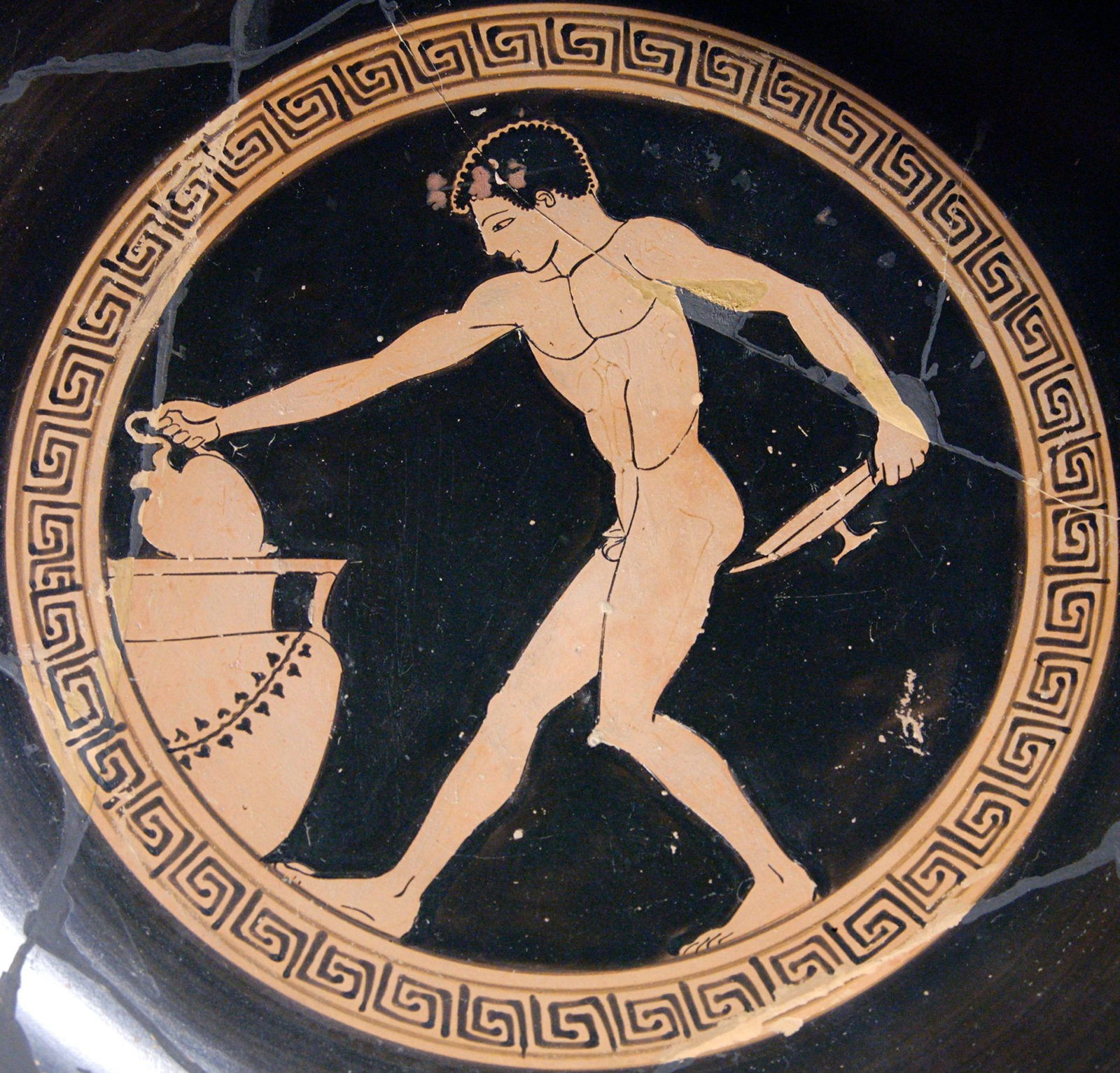
Ancient Greek depiction of a wine boy at a symposium. Image: Wikimedia / Cage Painter
Thanks to the Greeks' love of spreading their grape seeds, Italy's "boot" was soon invaded with wine at its "toe," and from there spread upward to ancient Rome. The Romans, in true Rome fashion, took the Greeks' wine culture and production methods to the next level. They made their own God of Wine, Bacchus, and spread vineyards in their own wake as they invaded the region encompassing modern day France, Italy, Portugal, Spain, etc.CHRISTIANITY ADOPTS WINE AS A MAJOR PILLAR OF ITS RELIGION
Eventually the Ancient Romans switched over from Paganism to Christianity, which you would think would mean less wine in Roman culture, but nay, once they were a nation of Christians they loved it just as much. Wine became a critical part of the sacrament — which is made up of Baptism, Confirmation, Holy Communion — and monasteries cultivated grapevines that were turned into wine and spread to taverns that were on monastery property. (Yeah, pretty good business model.)WINE PRODUCTION IN THE MIDDLE AGES
Wine continued to grow in popularity during the Middle Ages, and was eventually so ubiquitous that it became a common drink for all of the social classes in Southern Europe. Wine was also exported to other parts of Europe, but didn't catch on with the lower classes due to its increased price. (The commoners in the South were definitely having way better parties.)
Depiction of 13th century monk tasting wine from a barrel. Image: Wikimedia / Creative Commons
Catholic monks became one of the largest producers of wine in France and Germany, and numerous other monastic orders were deep into the wine game as well. Side note: Dom Perignon was a Benedictine monk. Where it was available and affordable, wine was served at every meal, both reds and whites. In fact, home recipes for mead from this period still exist today, as well as recipes for spiced and sweetened wine. Although, unfortunately or maybe fortunately, pretty much all of this wine was watered down to a paltry ratio of four to five parts water to one part wine.WINE TRAVELS FROM THE OLD WORLD TO THE NEW WORLD
Once European explorers started crossing the Atlantic on their ships, it was only a matter of time before wine would come to North and South America, a.k.a. the New World. The conquistadors were the first to bring wine to Mexico and Brazil, and it spread throughout South America from there. Spanish missions packed with wine-loving Catholics spread vineyards throughout South America, and eventually immigrants from France, Italy, and Germany all came over and brought their own, distinctive grape varieties along with them.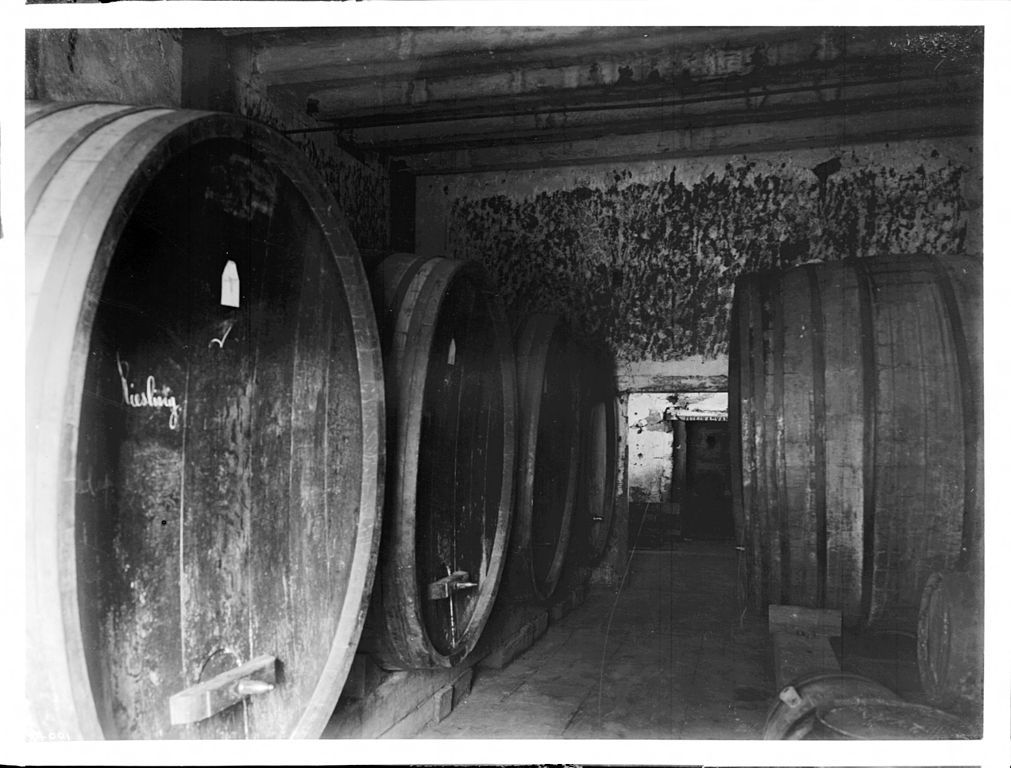
Wine barrels beneath an early 20th century Spanish Mission. Image: Wikimedia / Pierce, C.C. (Charles C.)
Wine became so popular in the New World that Mexico even began to outproduce Spain to the point where Spanish commercial production was negatively affected. This quickly ended when the Spanish king sent an executive order to Mexico forcing it to halt wine production. European settlers brought wine over to North America as well, although they initially had much less success than settlers in other areas of the New World. They weren't able to plant varieties from their home country, and they didn't like the local varieties. For example, the Huguenots tried making wine with local varieties in Florida but hated the flavor of the wine so much they stopped making it all together. In Canada, the French were the ones to first bring wine grapes over from Europe (duh), but they eventually settled on local varieties. Once wine had been properly introduced to North America by the Europeans it soon made its way across the continent, with events like the California Gold Rush helping to provide a catalyst for the cross continent trip.WINE IN MODERN DAY AMERICA
As mentioned, wine crossed North America in leaps and bounds, and in the U.S. moved from state to state, with New York and Ohio being two of the biggest early producers. Eventually California would enter the picture as the leading wine producer, however, and with its climate and size advantages would eventually outproduce the next largest wine-producing state, New York, by more than $20 to $1 in total sales. As with pretty much every other alcoholic drink, the wine market found itself struggling in the early decades of the 20th century, especially during Prohibition. Although, while the "above board" wine business was decimated, the amount of wine being made at home exploded from 4 million gallons before Prohibition to 90 million gallons during.
American workers filling and corking wine bottles in the early 20th century. Image: Wikimedia / W.C. Persons
After Prohibition, winemaking was not the industry it had been earlier in the century. Many expert winemakers had died, important vineyards hadn't been improperly kept up, and consumers began demanding cheap, inferior "jug wine." But America managed to make a comeback in terms of its wine quality in the 1970s, when researchers at the University of California, Davis gave winemakers and grape growers insight into how to best take advantage of different regions of California as well as how to maintain quality production. This led to California sweeping both the best red and white wine categories at the 1976 Paris Wine Tasting, the most prestigious wine-tasting competition in the world.
A wine vineyard in California. Image: Flickr / Harold Litwiler
As for what's happened in the wine industry in contemporary America, we'll get to that in The Future of Wine Section below. But before we get there, let's learn some more about wine itself, starting with how it's made!HOW WINE IS MADE
Although wine is an extremely complex and nuanced topic to explore, the actual wine-making process is fairly simple and straightforward, with the whole thing boiling down to seven essential steps. So let's take a look at them in case you need to drop some wine-making knowledge on somebody, or maybe even one day make some wine of your own.PICKING THE GRAPES
The first step in making wine is, of course, picking the grapes. This is generally done one of two ways: harvesting by hand or harvesting by a mechanical harvester, which is basically a big truck that travels down a row of vines, shaking off the grapes and collecting them via a conveyor belt system.
People picking wine grapes by hand. Image: Flickr / Stefano Lubiana
Again, when it comes to harvesting by hand versus mechanical harvesting, the differences are mostly subjective, although the two methods are obviously very different and serve different purposes. Hand harvesting is often utilized by smaller wineries because of the technique's precision with picking out the right grapes, whereas mechanical harvesters can "pick" grapes far faster and more efficiently. Another common difference in grape harvesting methods is day versus night harvests. Grapes picked at night are often done so in warmer climate terroirs, whereas grapes picked during the day are often done so in cooler climate terroirs. The reason for having one or the other is to keep stable grape sugar levels, which can vary if picked at the wrong time.
A mechanical harvester. Image: Flickr / Riversdale Estate
Once the grapes have been harvested, they're placed in giant bins or other collection receptacles. After that, problematic organic material such as stems and leaves are removed either by hand or by machine — this is called "destemming." Once this has been done, it's time for step two, crushing the grapes.BUT FIRST: WINE GRAPES VERSUS REGULAR TABLE GRAPES
As a quick side note, you'll want to know the difference between wine grapes and table grapes, because there is a big distinction, and all those snobby wine folks will expect you to know it. So here's a little basic breakdown of the differences in case the topic ever comes up. Wine grapes: You can easily spot a wine grape as it's significantly smaller and sweeter than a normal grape (it has 22-30% sugar content when it's harvested versus 15% for the average table grape), and surrounded by a much thicker skin. Wine grapes are also more acidic than table grapes and have much bigger seeds. This combination of thick skins, big seeds, and extreme sweetness make wine grapes far less appealing to eat than table grapes. (Duh.)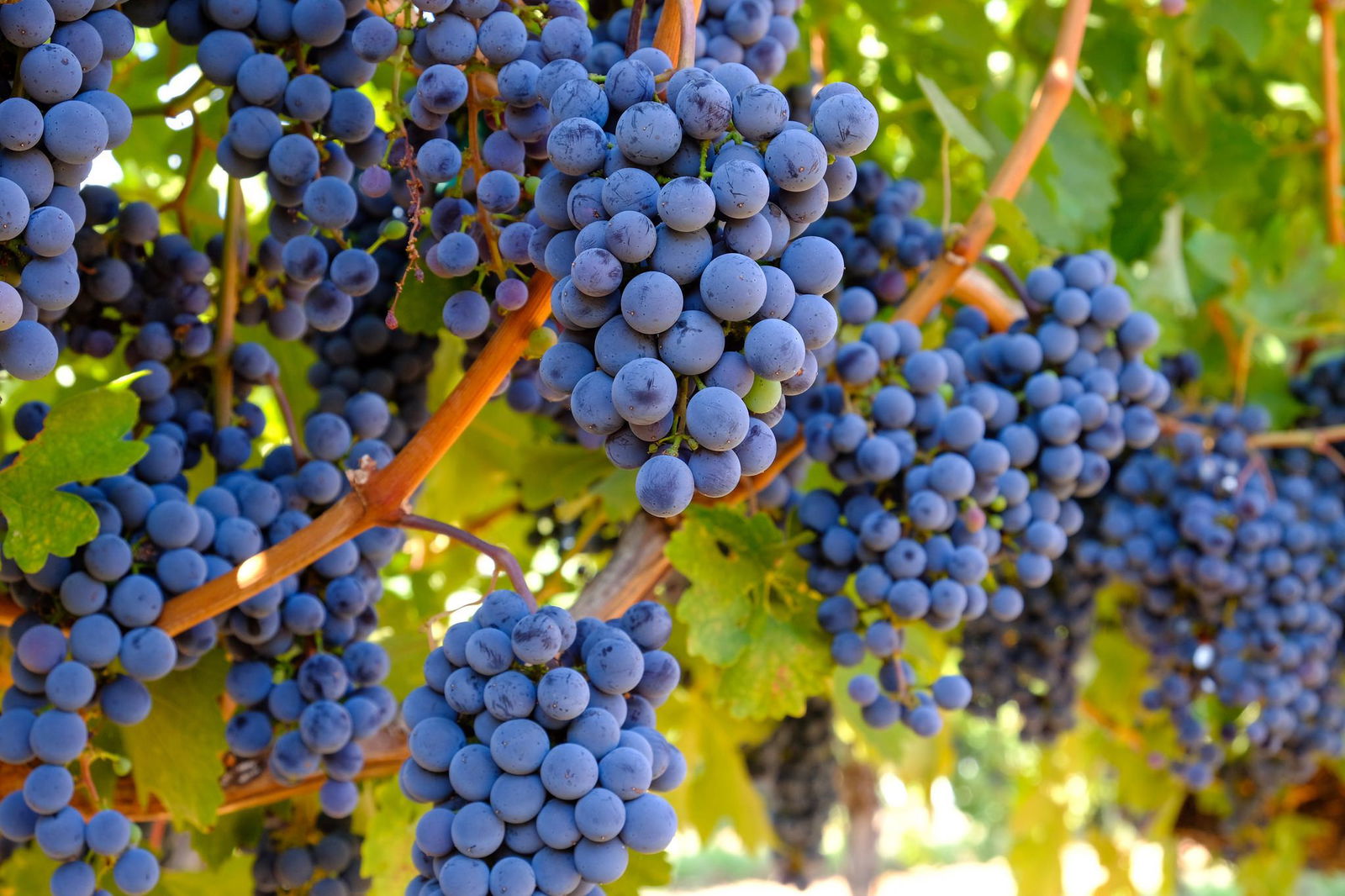
Wine grapes from Sonoma, California. Image: Flickr / brando
Table grapes: As can be deduced from the wine grape description, your average table grape will be larger, less sweet, and have a thinner skin. Table grapes have also been specifically bred to provide pleasing flavors and sensations for the mouth, which is why they pop so satisfyingly when you toss one in your mouth and bite down on it. Table grapes also have less juice and more pulp than wine grapes, which again gives them a more pleasing mouth feel when eaten. Side note: Roughly 90% of the grapes used for either wine or for the table belong to the species Vitis vinifera. Even though almost every single wine grape belongs to this species, there are still thousands of different varieties. What does that mean? Basically a variety can be thought of a kind of sub category in the species, distinguished by a set of characteristics that have been selected for. In fact, it would be more accurate to say that there are different cultivars of wine grapes rather than different varieties, as that is really the distinguishing factor. A cultivar is defined as a group of plants that's been bred to maintain a certain set of characteristics.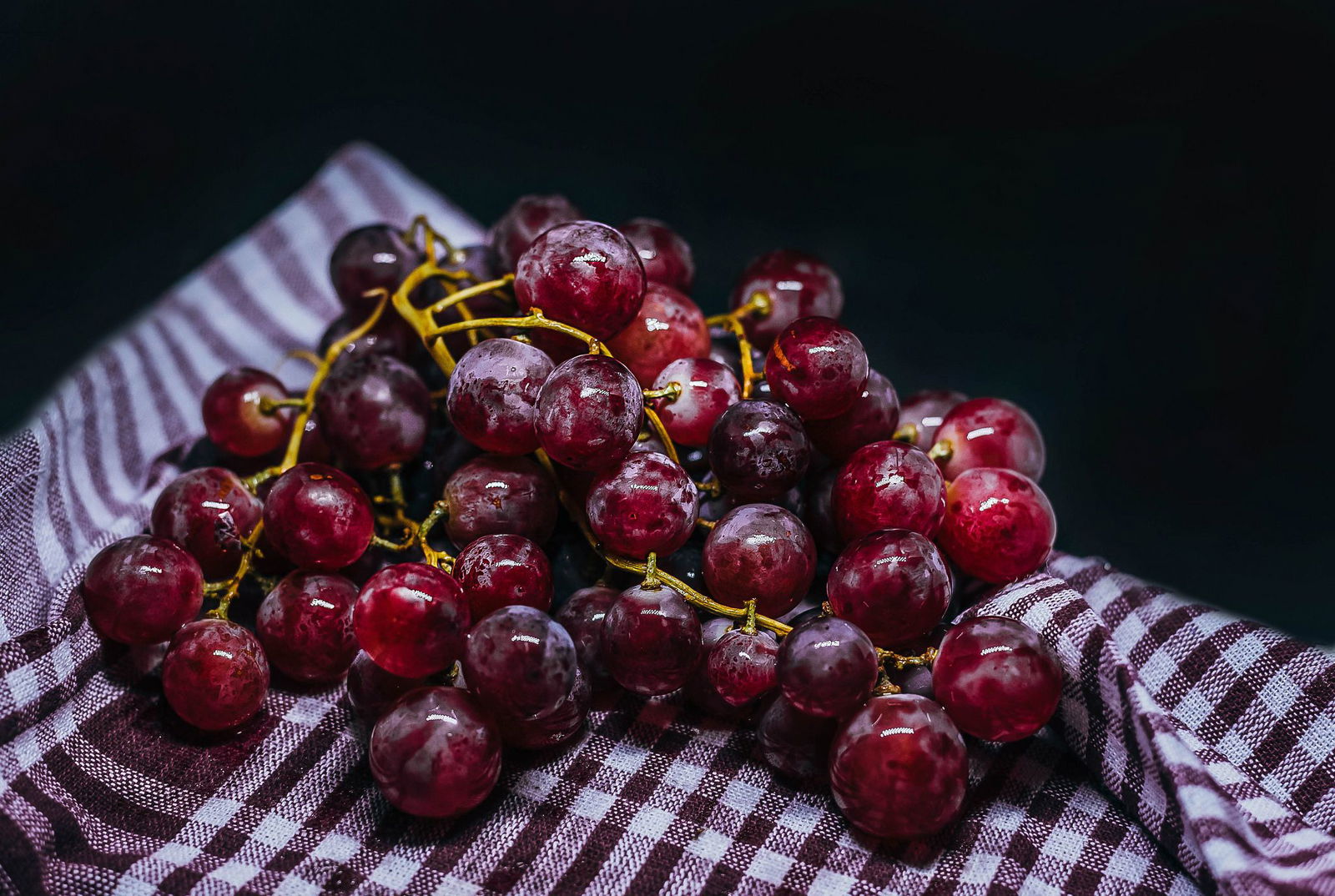
Fresh table grapes from Cologne, Germany. Image: Flickr / Marco Verch
CRUSHING THE GRAPES
Once the wine grapes have been pulled from the vines, collected, and destemmed, it's then time to start crushing them to extract their sugary juices that'll be used for fermentation. As with the grape-picking step, there are multiple ways to accomplish this step, including both mechanical and human-powered methods. You're probably already familiar with the human-powered method, because that basically consists of taking all of the grapes, sticking them in a giant tub, and letting a couple of people dance around on top of them with their bare feet (the feet are first cleaned with sulfur, which kills bacteria). This method is known as "pigeage" or grape stomping. The other method is to use a mechanical crusher, which obviously allows for a lot more grapes to be smashed, but with less precision, and, of course, a lack of human touch.
A modern-day wine press, although not necessarily the largest industrial version. Image: Wikimedia / Sanjay Acharya
There isn't much more detail to go into with this step — unless you want to get more specific about the different types of mechanical wine crushers out there, which is a topic that's just as exciting as it sounds — so all you need to know here is that the wine grapes are crushed to release their juices, and then have any of their excess stems, leaves, and skins removed.FERMENTING THE GRAPE JUICE
Now that the wine grapes have been collected, destemmed, and crushed, it's time to take the must (must is the term used for the freshly pressed grape juice) and do some fermentin'! And as with just about every other alcoholic beverage out there (read: literally every other alcoholic beverage out there), this step more or less just consists of adding yeast to the base sugar-providing liquid (in this case grape juice), and then allowing said yeast to munch on the sugars so that they can produce ethanol — a.k.a. booze that makes you tipsy.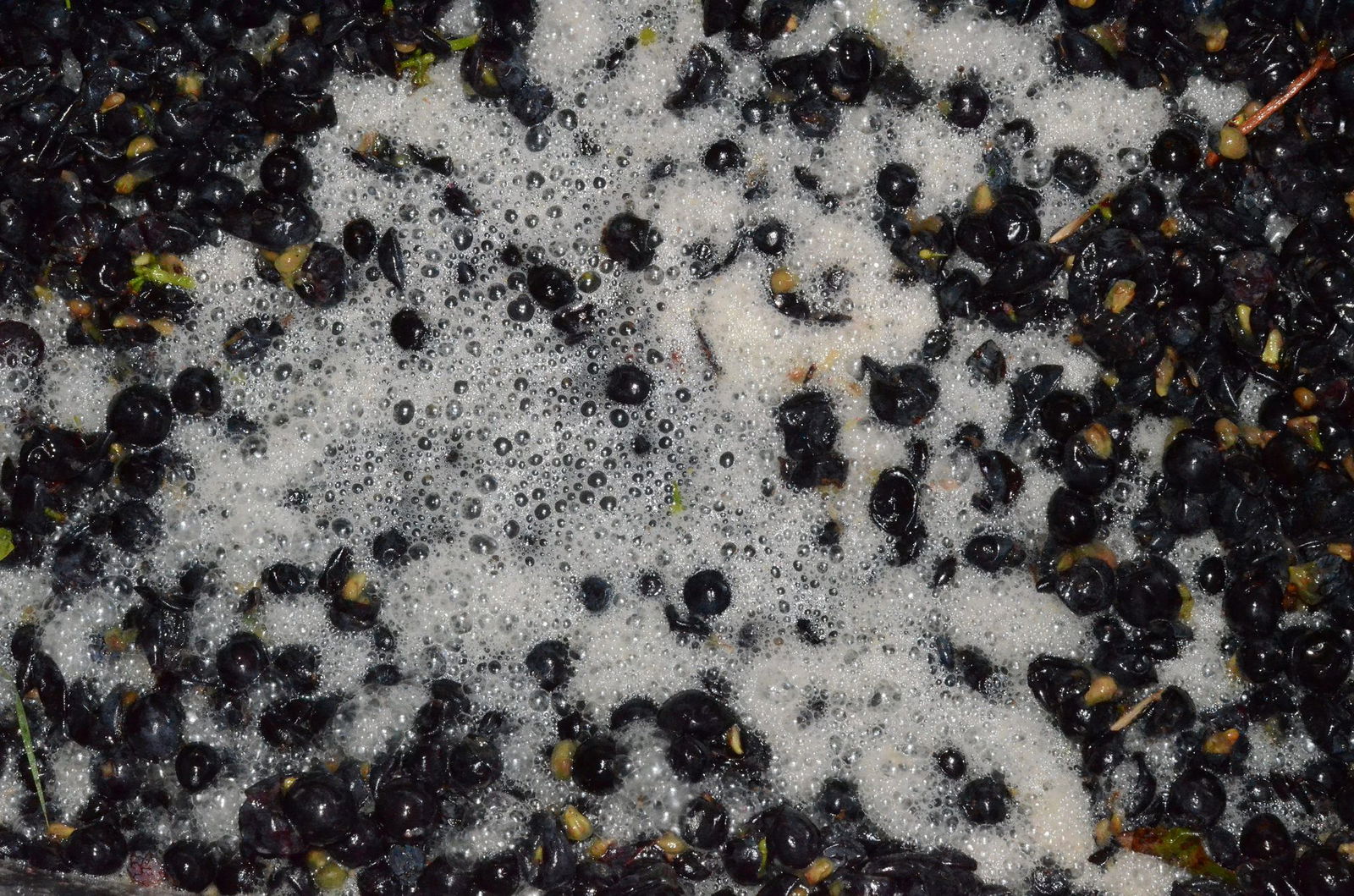
Cabernet Sauvignon must. Image: Flickr / Laurel Bank Wines
Any viniculturist who read the previous paragraph would probably want to slap somebody in the face because it's such an extraordinarily oversimplified explanation of the wine fermentation process, but still, that is basically what's going on with this step. Things get really complex when you start talking about factors like what temperature the must is fermented at, which types of yeast are used, and how much sugar content is in the must. There are also some more niche forms of fermentation such as bottle fermentation or carbonic maceration, but for all intents and purposes, you really just need to know that when it comes to winemaking, the fermentation step is about adding yeast to the sugary must so that it can produce ethanol (as well as a few other byproducts).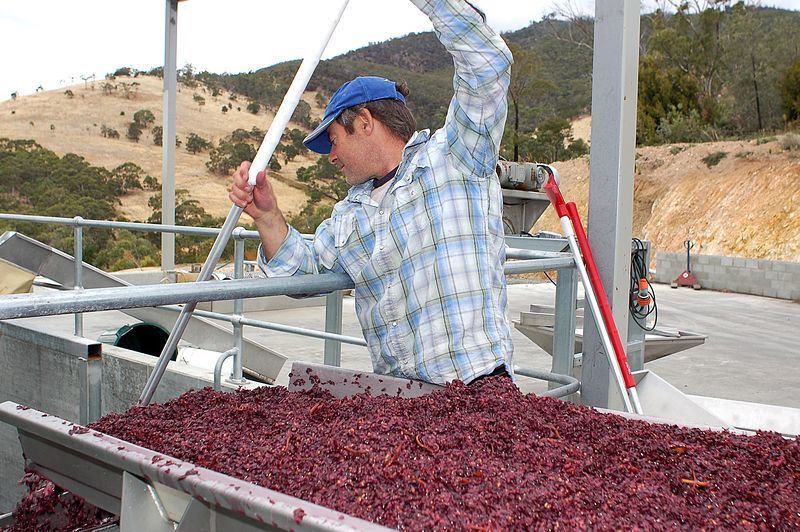
Winemaker pushes crushed Pinot noir grapes into a fermentation tank. Image: Wikimedia / Mark Smith
As a little side note, there is a process called "malolactic fermentation" that is critical for the winemaking process for many red wines as well as full-bodied white wines. Basically malolactic fermentation is the process by which lactic acid bacteria converts malic acids in the must into lactic acid. Because the lactic acids are smoother than the harsher-tasting malic acides, malolactic fermentation can provide a softer mouthfeel as well as a smoother overall flavor. In other words, malolactic fermentation helps to mellow out a given wine. IMPORTANT NOTE: Although both the musts for red and white wines are (obviously) fermented, the grape skins are only kept on for red wine fermentation. It is from these red grape skins that red wine gets its color.BARREL AGING (OR STEEL TANK AGING) THE WINE
OK, the grapes have been picked, destemmed, crushed, and fermented, which leaves only one more step before bottling: barrel aging. And while barrel aging, like all of the other steps involved in wine making, can be a nuanced, complex process, the fundamental steps involved are still simple. Take the freshly fermented wine, place it in barrels — or stainless steel tanks — and let it sit there for a year or two. The amount of time that a given wine will sit in a barrel or tank will vary greatly depending on the vintner (the winemaker), the type of wine being aged, and the rules regulating the wine aging, which depend on the region in which a given terroir is located.
Wine barrels and tanks. Image: Flickr / Naotake Murayama
In terms of why wine is barrel aged, that, of course, is a matter of improving and mellowing out a given flavor profile. When wine is aged in barrels, it absorbs various flavor compounds, such as tannins, which can affect everything from aroma to color to mouthfeel. The five major ways that wood (almost always oak) barrels can affect wine are listed below. Note that these steps are taken from the Ultimate Whiskey Guide, as the benefits of barrel aging are essentially the same for wine and whiskey. Extraction: Extraction is all about the wine seeping into and out of the wood barrels in order to grab flavor compounds. As temperatures change, so does pressure inside of the barrel. Warmer temperatures cause an increase in pressure, forcing the wine into the porous membrane of the wood, where it snatches flavor compounds such as vanillins (chemical compounds that provide vanilla flavoring) and tannins (chemical compounds that provide dry, sharp flavors similar to those of wine or black tea). When the temperature cools and pressure decreases, the wine drips back out of the wood, bringing along those flavor compounds. To imagine this process, you can think about the wood barrel expanding and contracting as it breathes the wine in and out. Evaporation: Because the wood that the casks are made of is porous, some of the alcohol inside the cask evaporates — this evaporated alcohol is known as The Angels’ Share, and usually happens to the tune of about 2% every year. Which means if you barrel age a particular wine for 5 years, you could lose up to half the alcohol content. Note that water can and does also evaporate; higher humidity will cause more alcohol to evaporate, lower humidity will cause more water to evaporate.
Oak wine barrels. Image: Wikimedia /
Oxidation: Oxidation is another process that occurs during the barrel aging process, which also has an effect on the final product’s flavor profile. Because the porous barrels have permeable membranes, they allow in small amounts of oxygen, which in turn react chemically with some of the compounds in the wine. These chemical reactions lead to the proliferation of flavor compounds, especially a group of compounds called esters, which are created during fermentation and responsible for flavors that tend to be fruity, creamy, and floral.BLENDING
After a wine has been through all the other steps mentioned, and pulled out of the barrel, it's then time to start drinking, right? Not necessarily! There are still a couple more common steps that are involved in the wine-making process, and while they may be somewhat optional, they're still hugely popular and hugely important. First up is blending: Blending wines, as you'd guess, is a matter of blending wines from different barrels of the same vintage, or from different vintages, in order to achieve some specific flavor profile that's either desired by a winemaker, or maybe even a person at home who just wants to mess around and see if wine from different bottles work well together.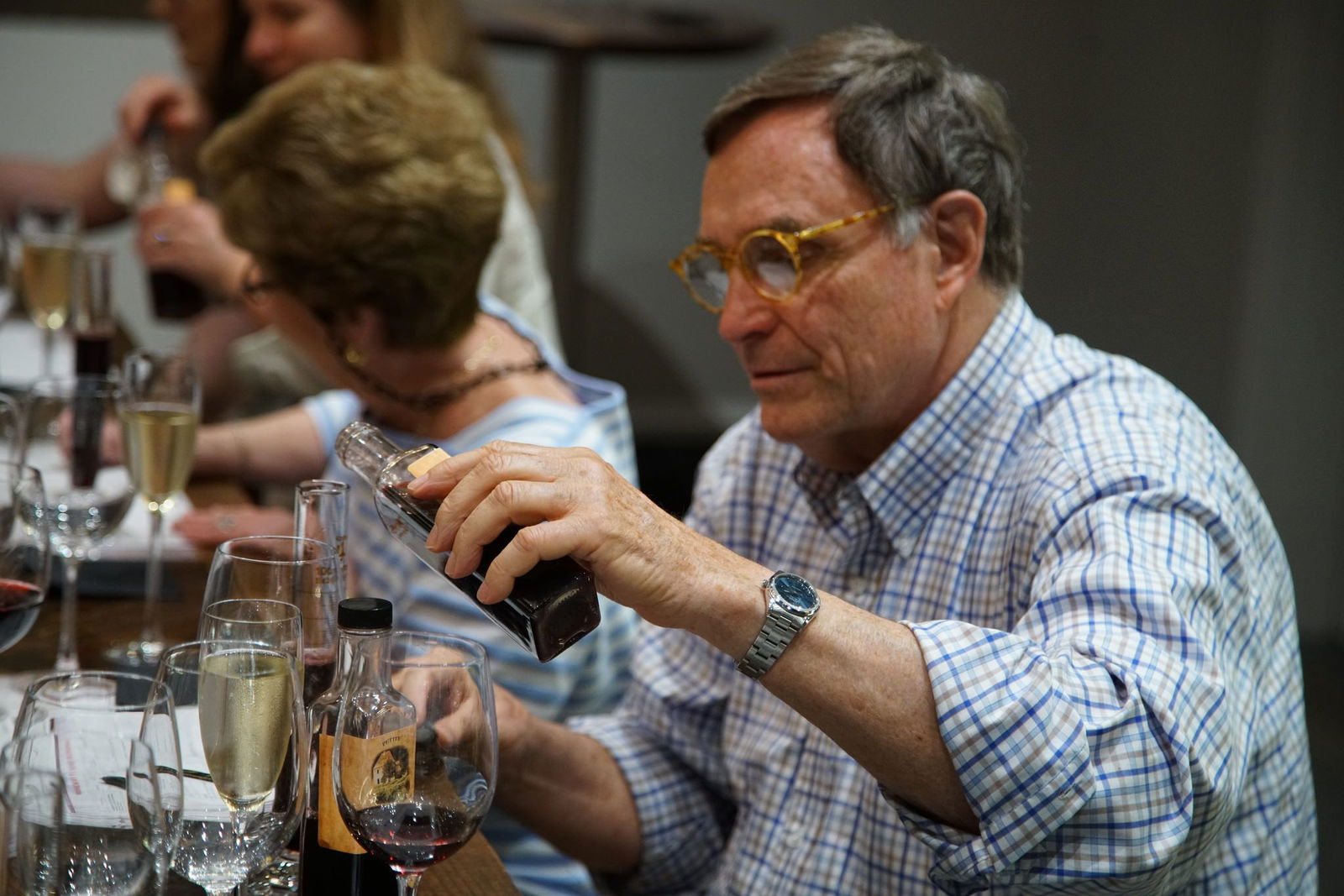
Amateur wine blending. Image: Flickr / UNC KenanFlagler
If you hear the word "blending" or "blend," and think that immediately makes for a cheaper wine, we are happy to tell you that it most certainly does not. Numerous top-tier wines are blends, including those from Champagne, California, South Africa, and Australia, among many other wine-producing regions. But why blend exactly? We'll tell you why! Blending wines — either whites or reds — is a common practice because it helps to smooth out the flavor profile and/or make the wine more complex, it can be an effective way for winemakers to stabilize the flavor of a given wine type across bottles, and it can be a great way for home drinkers to improve the taste of their bottles. Things obviously get complex and nuanced when it comes to blending wine — the same story with everything wine related, right? — but as a general rule of thumb, winemakers will aim to blend in order to achieve the best taste possible, as well as to keep flavors consistent amongst bottles. In fact, almost all wines out there are blends of one type or another; some might blend different vineyards or barrels of a single variety, others may blend different appellations or varieties.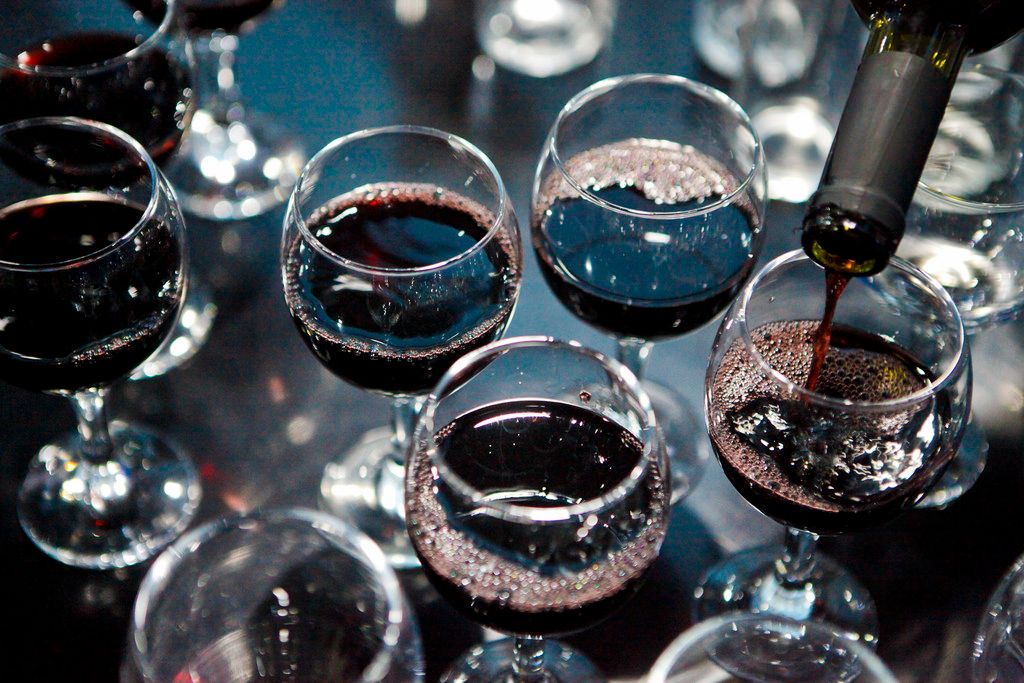
Wine pouring. Image: Flickr / Faisal Akram
As far as blending wines at home, there's usually only two rules of thumb to obey: don't mix red and white wines (super duh) and don't mix cheap and expensive wines. Other than those two guidelines, mixing at home really just comes down to personal taste preferences — in other words, experiment with different mixtures until you find the perfect blend for you. Having a notepad and pipette is also very useful as well; keeping track of your blends with notes will help you to make sure you don't forget how you made that perfect blend, and having a pipette will help you to add wines more accurately and without mess.CLARIFICATION AND STABILIZATION
After a given wine has been blended, it's then time to clarify and stabilize it. These are actually optional steps, but they're done so frequently we think it's necessary to cover them! The following processes are the most common ways of clarifying and/or stabilizing a given wine:FINING
Fining a wine is all about adding a "fining agent" — such as gelatin, egg whites, skim milk, copper sulfate, hydrated yeast or even blood (!!!) — so that the wine is cleansed of organic compounds that can negatively affect the appearance or flavor of the wine. The organic compounds that can negatively affect the flavor or appearance of the wine include sulfites, proteins, polyphenols, and benzenoids, just to name a few. Bentonite (which is similar to mud in consistency) is used as a fining agent to settle out the solids from the pressed wine-grape juice. Image: Wikimedia / Robert Pitkin
Fining agents accomplish their task by binding with the unwanted organic compounds, making them heavy enough to settle out at the bottom of the wine (usually in the wine barrel). The result of adding a fining agent to wine is often a softened, less astringent, less cloudy end product.
Bentonite (which is similar to mud in consistency) is used as a fining agent to settle out the solids from the pressed wine-grape juice. Image: Wikimedia / Robert Pitkin
Fining agents accomplish their task by binding with the unwanted organic compounds, making them heavy enough to settle out at the bottom of the wine (usually in the wine barrel). The result of adding a fining agent to wine is often a softened, less astringent, less cloudy end product.
FILTRATION
Filtration is exactly what it sounds like: running the wine through a filter in order to rid the wine of unwanted impurities. Again, there is a ton of nuance with the types of filtering methods out there, but when you think of filtering wines just think of passing wine through a filter pad (such as a cellulose fiber) by either using a pressurized wine filter system or just good ol' gravity.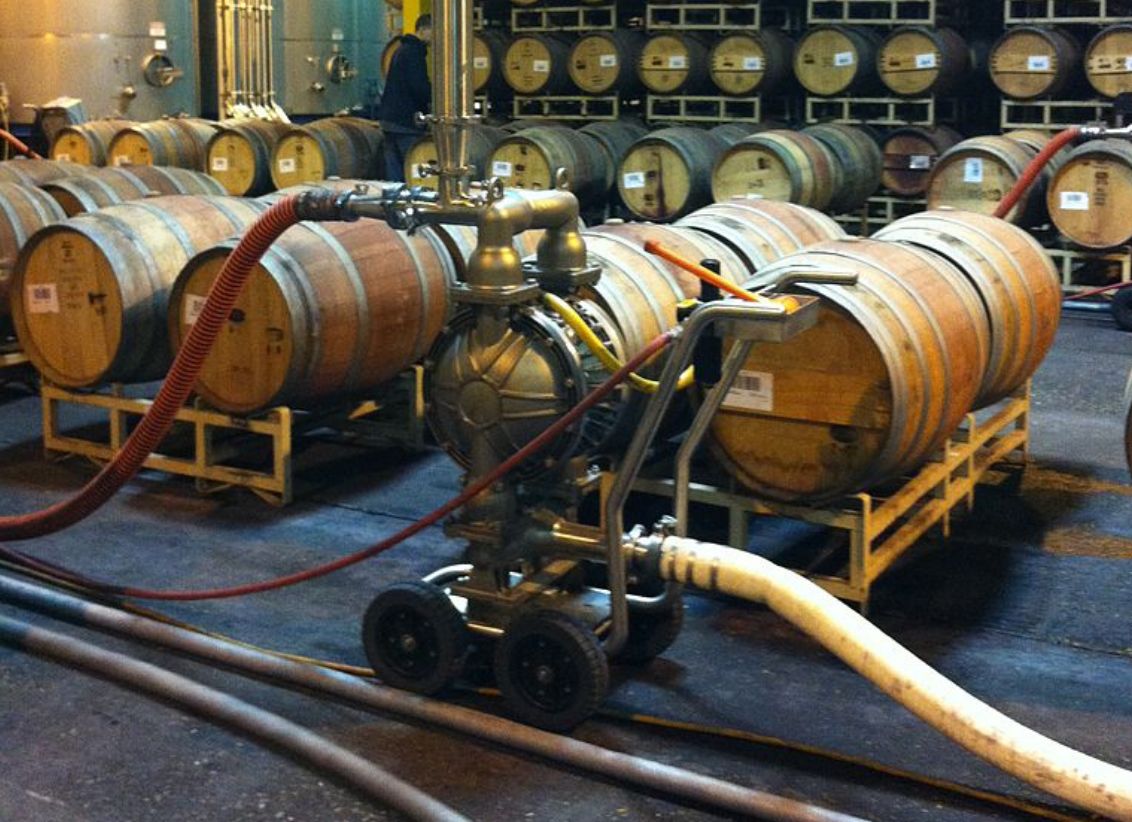
A pump used for the racking and transfer of wine with a membrane filter attached. Image: Wikimedia / Agne27
OTHER METHODS OF CLARIFICATION AND STABILIZATION
Other methods for clarifying and stabilizing a given wine include centrifugation, flotation, refrigeration, pasteurization, and racking, although it's not all that critical to know about these methods as a home bartender — or a home winemaker for that matter. Basically, all of these methods aim to do the same thing as fining or filtration: get rid of unwanted organic particles. Centrifugation, for example, accomplishes this task by using the centrifugal force (or perhaps the centripetal force if you want to have that argument) to pull impurities out of the wine.BOTTLING THE WINE
Finally! The grapes have been picked and crushed, the must has been fermented, the fermented must has been barrel aged, and the barrel-aged wine has been blended, fined, and/or filtered. This means it's time for the last glorious step of the wine-making process: bottling!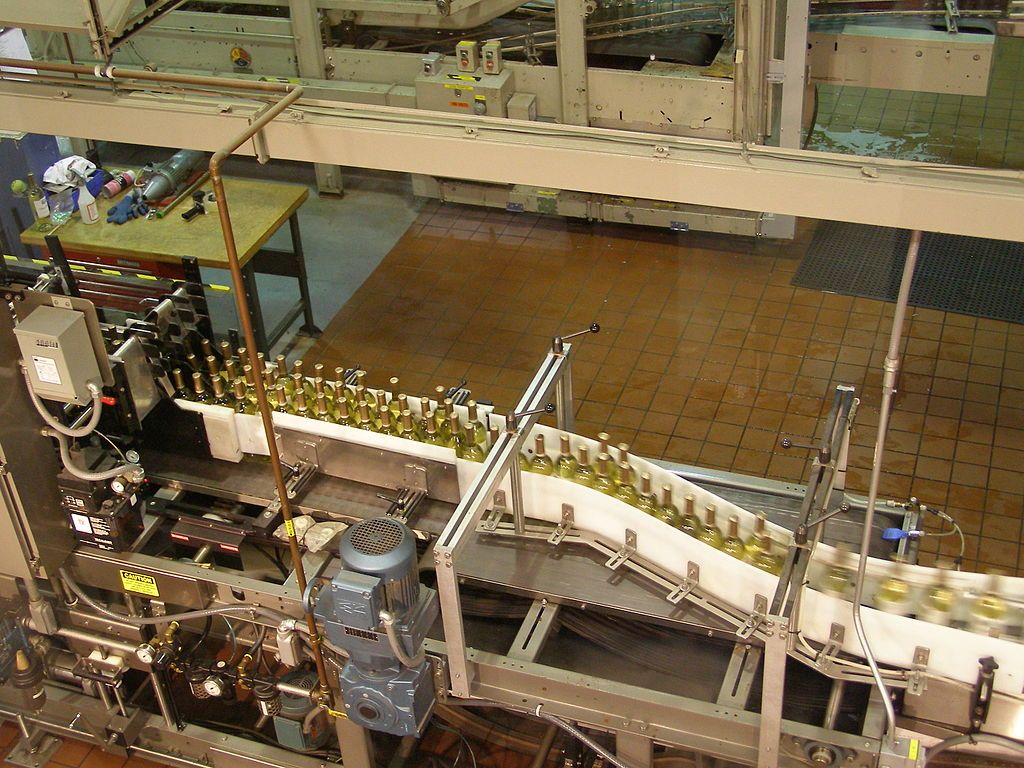
Bottling wine at Chateau Ste Michelle in Washington state. Image: David Herrera
As you'd imagine, the bottling step basically consists of taking your freshly made wine, sticking it in bottles, and then corking them bottles up so that they can be delivered to liquor stores and markets across the world. But while large-scale industrial winemaking operations have giant machines to bottle their wines, smaller producers need to follow a more work-intensive, human-powered routine. Below are some basic home-bottling guidelines to keep in mind: Double-check your wine's clarity: Before you bottle your wine, make sure it's cleared of pesky impurities! (Remember how we talked all about that in the previous section?) Anyway, the best way to check to see if there are impurities in the wine is to shine a flashlight through it — if the wine is cleared of impurities, you won't be able to see the light pass through the wine. If you can see the light pass through the wine, then that means there are impurities, as the light is bouncing off tiny little floating particles. The cheapest and easiest way to filter your wine, if it has a bunch of impurities in it, would be to use a gravity flow filter. Basically this is a setup whereby you connect a tube to your barrel of wine, let the wine flow through the tube (thanks to gravity!), and then let it pass through a filter pad before going into a collection container. Gravity flow filters can either be built as a one-off or you can buy the whole set up for pretty cheap online.
A whole lot of homemade wine. Image: Wikimedia / Crosslers
Sanitize your wine bottles: Once you're sure that your wine is cleared of all impurities, then it's time to actually get the wine in the bottle! Err, almost. First, you need to make sure that your wine bottles are completely sanitized. Why? Because if they aren't, if they have some mold in them, for example, then your wine will be ruined. So it's really important that the bottles be cleaned! In terms of how to clean the bottles, you'll want to use a potassium metabisulfite solution (basically a disinfectant) to clean out the inside of the bottle. Make sure to get literally all of the mold, dirt, grease, etc. out of the bottle — whether it's a recycled bottle or not — as any of that can completely ruin the flavor profile of your wine. To get the potassium metabisulfite into the bottle, you can either fill a bucket with it and then submerge your wine bottles or you can use a funnel to pour the solution directly into the bottle. Sanitize your corks: Sanitizing your corks is just as important as sanitizing your bottles: to do this, all you need to do is submerge your corks in your sodium metabisulfite (you can fill a jar and stick both the corks and the metabisulfite in it) or you can just straight up steam the corks. Both of these methods will not only fully sanitize your corks, they'll also make sure they're the right softness for plugging up the neck of a wine bottle!THE DIFFERENT TYPES OF WINE
Alright, alright, alright, we now know what wine is, where it comes from, and how it's made. Which means it's time to learn about all of the major wine categories and types — and there are a lot of them, so buckle up and prepare to hear (read?) a whole bunch of French terms. Also, keep in mind that when you hear a term like "Riesling," "Chardonnay," "Syrah," or "Merlot," it's a reference to the grape variety.WHITE WINES
First up, we have our white wines. We'll take a deeper dive into white wine versus red wine in the How to Drink Wine section below, but for now, you just need to know that white wines are generally thought of as zesty, acidic, and infused with floral aromas and fruit notes. With that general flavor description in mind, let's take a closer look at specific types of white wine that you may want to swish, sip, and spit. (The spitting is definitely not necessary....)RIESLING
Riesling is a white grape variety that's generally described as flowery, perfumed, and highly acidic. In cooler climates, Riesling wines often exhibit apple and tree fruit notes, while those that are grown in warmer regions generally have more peach and citrus notes. The fact that Riesling grapes are high in acidity also means that wines made from this grape type have solid aging potential, as well as a flavor profile that's often smokey and hinted with notes of honey.
Riesling wine grapes. Image: Wikimedia / Creative Commons
Some of the best Riesling Wines include: 2016 Eroica Riesling, 2017 Cold Creek Riesling Vineyard Riesling, 2015 Ethos Late Harvest Riesling, 2015 Domaine Zind-Humbrecht RieslingPINOT GRIS (PINOT GRIGIO)
Pinot gris, often referred to as Pinot grigio, are white wine grapes that are actually thought to be a mutant clone of the Pinot noir variety. Wines made from Pinot grigio grapes are split up into two types: full-bodied Alsatian wines and lighter-bodied, more acidic Italian-style wines. The Alsation wines, so named because their grapes are traditionally grown in the Alsace region of France (although other regions in the world grow the same time), tend to be less acidic with lower alcohol levels and a texture that is described as "oily." Both types of Pinot grigio wines are often described as having a flavor profile infused with notes of tropical fruit, melon, mango, lime, lemon, pear, white nectarine and apple. (This depends on where the Pinot grigio grapes have been grown, whether that be in France, the U.S., or Italy.) Some of the best Pinot grigio wines include: Canyon Road Pinot grigio, Santa Margherita Pinot grigio, Jermann Pinot grigio, Voga Pinot grigio, Kris Pinot grigioSAUVIGNON BLANC
Sauvignon blanc is a variety of green-skinned grape that originates in the Bordeaux region of France, although it's now cultivated in Chile, Canada, Australia, New Zealand, South Africa, and California as well. In warmer climates, Sauvignon blanc produces more "green flavors" that are usually described as grassy and similar to bell peppers, but are also infused with tropical fruit and floral flavors. In warmer climates, Sauvignon blanc is infused with notes of tropical fruits, as well as tree fruits such as peaches. When chilled, Sauvignon blanc pairs well with cheese, fish, and even sushi. Also note that Sauvignon blanc generally doesn't benefit from aging, and should instead be consumed young.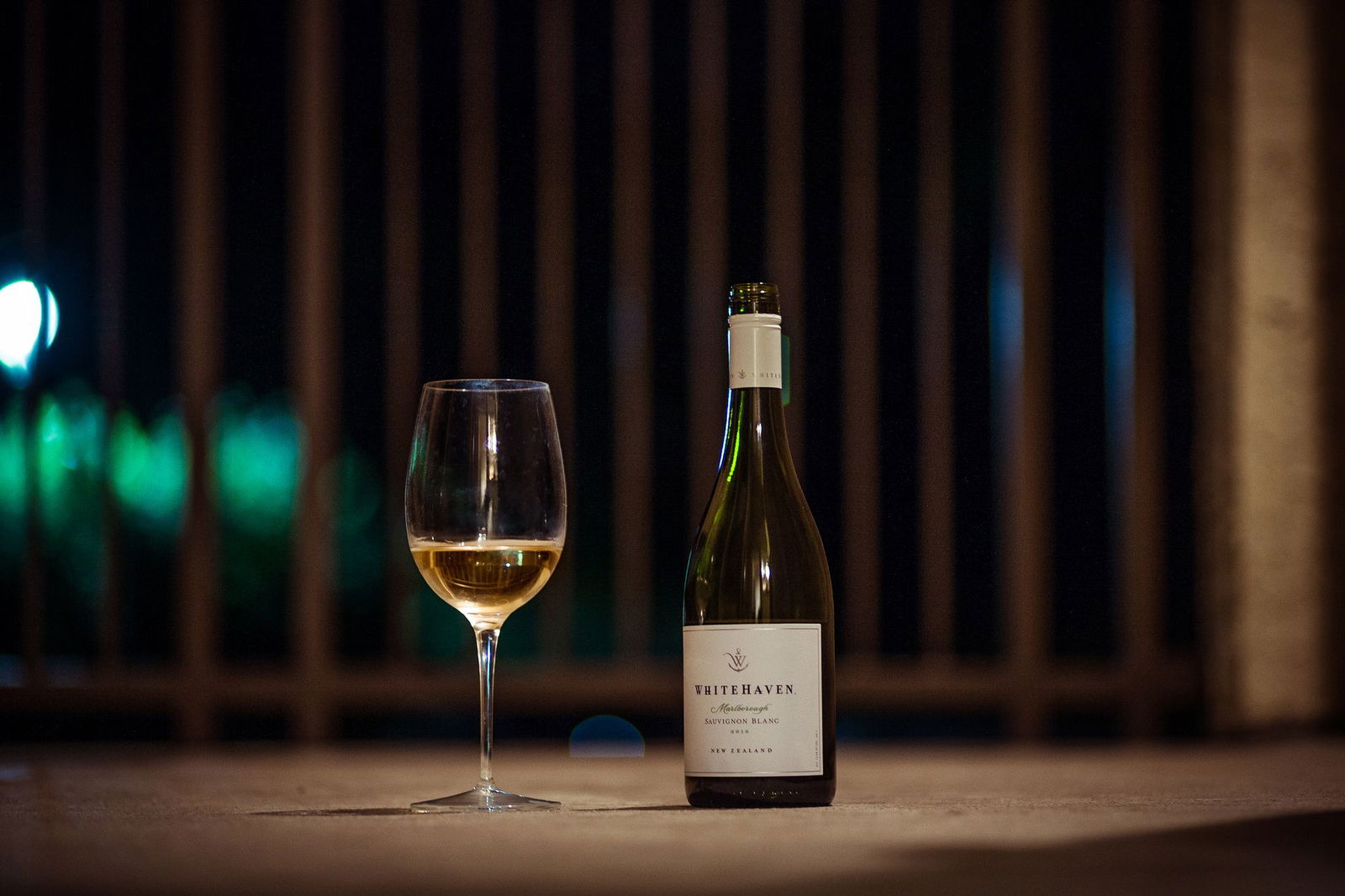
A bottle of Sauvignon Blanc. Flickr / Nigel Greenlawn
Some of the best Sauvignon blanc wines include: 2011 Franciscan Napa Valley Sauvignon blanc, 2011 Lake Chalice Marlborough Sauvignon blanc, Alphonse Mellot La Moussiere Sancerre, 2011 Geyser Peak California Sauvignon blanc, 2011 Montes Limited Selection Leyda Vineyard Sauvignon blanc.CHARDONNAY
Chardonnay grapes are grown in various regions across the globe including France, California, Australia, and New Zealand among others. In cooler climates, wines made from Chardonnay grapes tend to be medium to light bodied, with notes of green plum, apple, and pear. In warmer climates, Chardonnay-derived wines tend to have flavor profiles infused with citrus, melon, peach and fig, and tropical fruit, banana, and mango in the very warm climates. Some of the best Chardonnay wines include: Penfolds Koonunga Hill Chardonnay, Chateau Ste. Michelle Chardonnay, Benziger Sonoma County Chardonnay, Heron Hill Classic Chardonnay Unoaked, Kendall Jackson Vintner's Reserve ChardonnayMOSCATO WHITE WINE
Moscato is an Italian white wine made from the muscat family of grapes. Moscato is popular as an aperitif — a boozy drink to have before a meal to whet one's appetite — because it's low in alcohol content, sweet, and easy to sip on. Moscato also works well as a dessert wine, as it has a slight fizz, and is infused with notes of peach, orange, and nectarine. Side note: Muscat grapes are so tasty they work just as well as table grapes as they do as wine grapes.
A bottle of Moscato. Image: Flickr / Gail
Some of the best moscato white wines include: Castello del Poggio Moscato, Cupcake Moscato 2013, Ecco Domani Moscato 2011, Saracco Moscato d'Asti 2013, Beni di Batasiolo Moscato d'Asti Bosc dla Rei 2013RED WINES
Red wines are not only made from red grapes, but the red grapes used to make red wine also have their skins and seeds left on/in during the wine-making process. This means that red wines contain much larger amounts of tannins versus white wines — as both the grape seeds and skins are major sources of tannins — and thusly almost always have a more bitter flavor profile than white wines. Red wines also almost always have a bolder flavor with more complexity, as well as much stronger mouthfeel — i.e. the texture of the wine (silky, smooth, viscous) will be much more prominent.PINOT NOIR
Pinot noir grapes are grown around the world, but they're mostly associated with France's Burgundy region. Pinot noir is considered to be one of the most prestigious (read: snobby) types of red wine because it's so hard to grow the grapes that are used to make it. (Yes, this does mean that a really good bottle of Pinot can be hard to find. It also means that if somebody does find a good bottle, you'll probably never hear the end of it.) As far as flavor profile is concerned, Pinot noir wines tend to be medium bodied with fruity notes including those of strawberry, cherry, raspberry, and blackberry. Pinot noir wines also tend to have some earthier flavors as well, including those of herb, mushroom, leather, as well as notes of warm spice, cinnamon, clove, and smoky tobacco.
A Pinot noir harvest. Flickr / Jim Fischer
Some of the best Pinot noir wines include: Melville 2016 Sandy's Pinot noir, Brittan Vineyards 2015 Cygnus Block Pinot noir, 2014 The Pinot Project California Pinot noir, 2014 Union Wine Company Underwood Pinot noir, Foxen 2016 Solomon Hills Vineyard Pinot noirZINFANDEL
Zinfandel is a California wine through and through; in fact, over ten percent of all California wine vineyards, black-skinned Zinfandel grapes. Zinfandel wines are distinguished by their unusually high alcohol content — which usually ranges from 14 to 17 percent — as well as their fruity, jammy flavor profiles. Some of the flavors to expect from a standard Zinfandel include blueberry, black pepper, plum, cranberry, licorice, boysenberry, and cherry. Some of the best Zinfandel wines include: Robert Biale 2016 Bedrock Vineyard Zinfandel, Ledge 2016 Dante Dusi Vineyard Zinfandel, Rock Wall 2016 Alegria Vineyard Zinfandel, Buehler 2015 Zinfandel, Kreck 2016 Teldeschi Vineyard Old Vine ZinfandelSYRAH & SHIRAZ
Syrah (or Shiraz if you want to say it like the Aussies do) is a type of dark-skinned grape that's native to France. Syrah wines are some of the darkest on the market, and are loaded with mouth-drying tannins. The flavor profile of most Syrah wines consists of berries, tobacco, smoked meat, and pepper. Some of the best Syrah wines include: Jam Jar Sweet Shiraz, Molly Dooker Shiraz The Boxer, Rubus Shiraz Barossa, Yellow Tail Shiraz, Shotfire Ridge ShirazCABERNET SAUVIGNON
Cabernet Sauvignon is one of the most popular red wine grape varieties in the world, and is, depending on the year, the most widely planted wine grape out there. Cabernet Sauvignons are known for having an especially dark color, as well as a full body and an alcohol content that generally ranges from around 13 to 15%. Most Cabernet Sauvignons have plenty of tannins, making them especially dry, as well as high levels of acidity. Thanks to this high acidity and alcohol content, it's commonly preferred to drink Cabernets with a meal. In terms of flavor, Cabernet Sauvignons offer hints of green pepper, tobacco, cassis, vanilla, and fruits like cherries.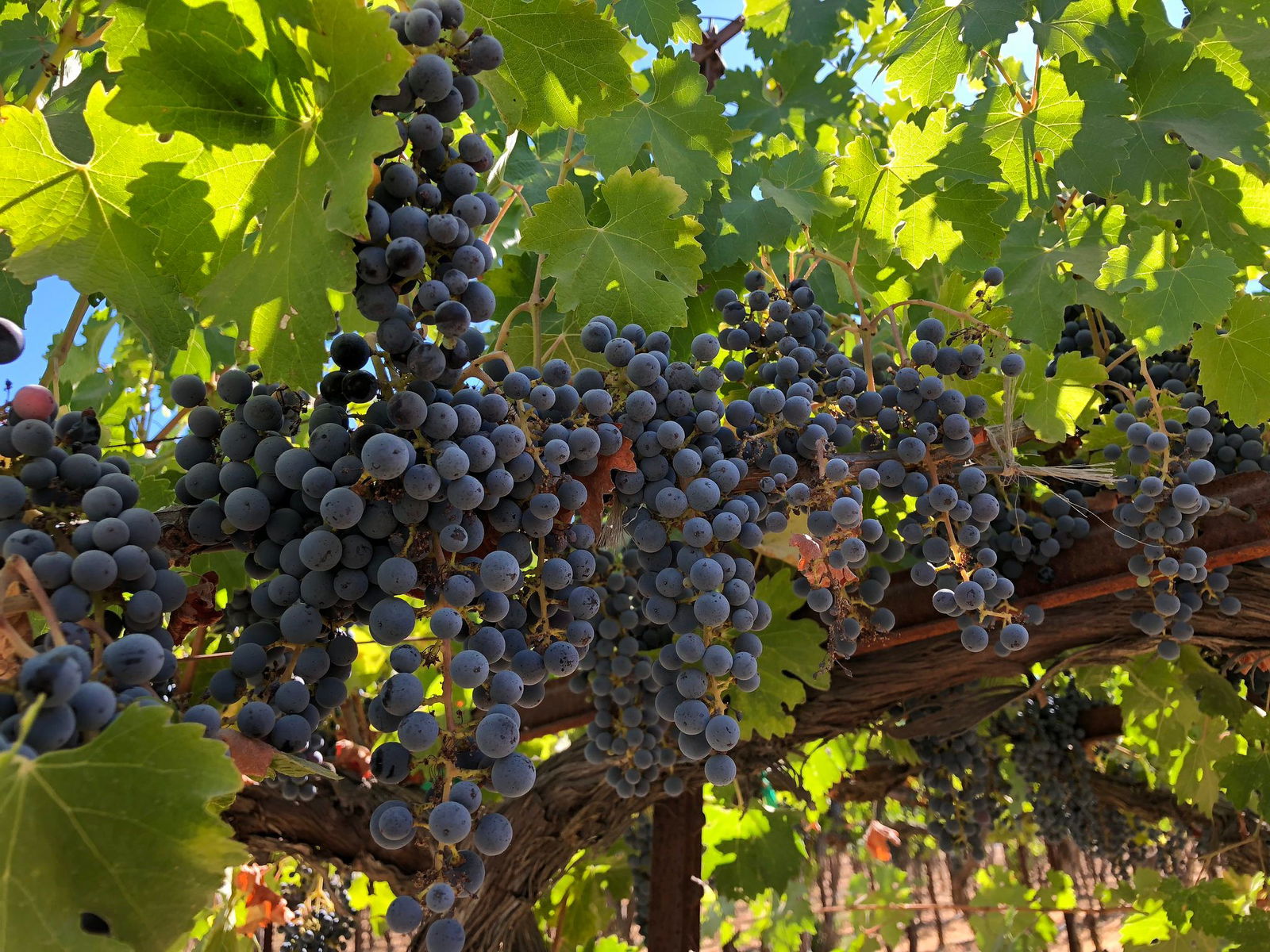
Cabernet Sauvignon wine grapes. Image: Flickr / Sarah Stierch
Some of the best Cabernet sauvignon wines include: Nottingham Cellars 2014 Cabernet Sauvignon, Falcone 2015 Cabernet Sauvignon, Black Stallion 2015 Cabernet Sauvignon, Obsidian Ridge 2015 Estate Grown Obsidian Ridge Vineyard Cabernet Sauvignon, Ruby Hill Winery 2014 Reserve Collection Cabernet SauvignonMERLOT
While Cabernet sauvignon wine grapes are the most popular wine grapes in the world, Merlot grapes are the most popular variety in France. Merlots, like Cabernets, tend to work best when paired with food. Overall, Merlots tend to be quite similar to Cabernets, although they're less acidic and usually have a more lush mouth feel. Flavor-wise, they usually combine fruity notes of currant, black cherry, and plum with herbal notes of bell pepper and green olive. They can also offer caramel, clove, bay leaf, and green peppercorn spice notes. Some of the best merlot wines include: Duckhorn Vineyards Merlot, Marilyn Monroe Wine "Marylin Merlot," Blackstone Winemaker's Select Merlot, Low Hanging Fruit Merlot, Radius Merlot.MOSCATO RED WINE
Moscato red wine is a very sweet, very fruity Italian wine usually drunk as a dessert wine. Moscato red wines generally have very low alcohol by volume percentage (somewhere around 5 to 7%) and usually have a hint of fizz. Some of the best moscato red wines include: Michele Chiarlo Nivole, Moscato d'Asti, Elio Perrone Sourgal, Barefoot Red Moscato (for the very cheap option)ROSÉ (KIND OF)
Rosé is almost but not quite a red wine, because while it's made from red grapes that have their skins left on during the winemaking process, they're not left on for long — only 12 to 24 hours. Because the skins aren't left on for longer, and because the skins are what give red wines their red color, rosés turn out pink rather than red. (There are multiple methods for creating this distinctive rosé pink color, including the maceration method, the saignée method, and the blending method.)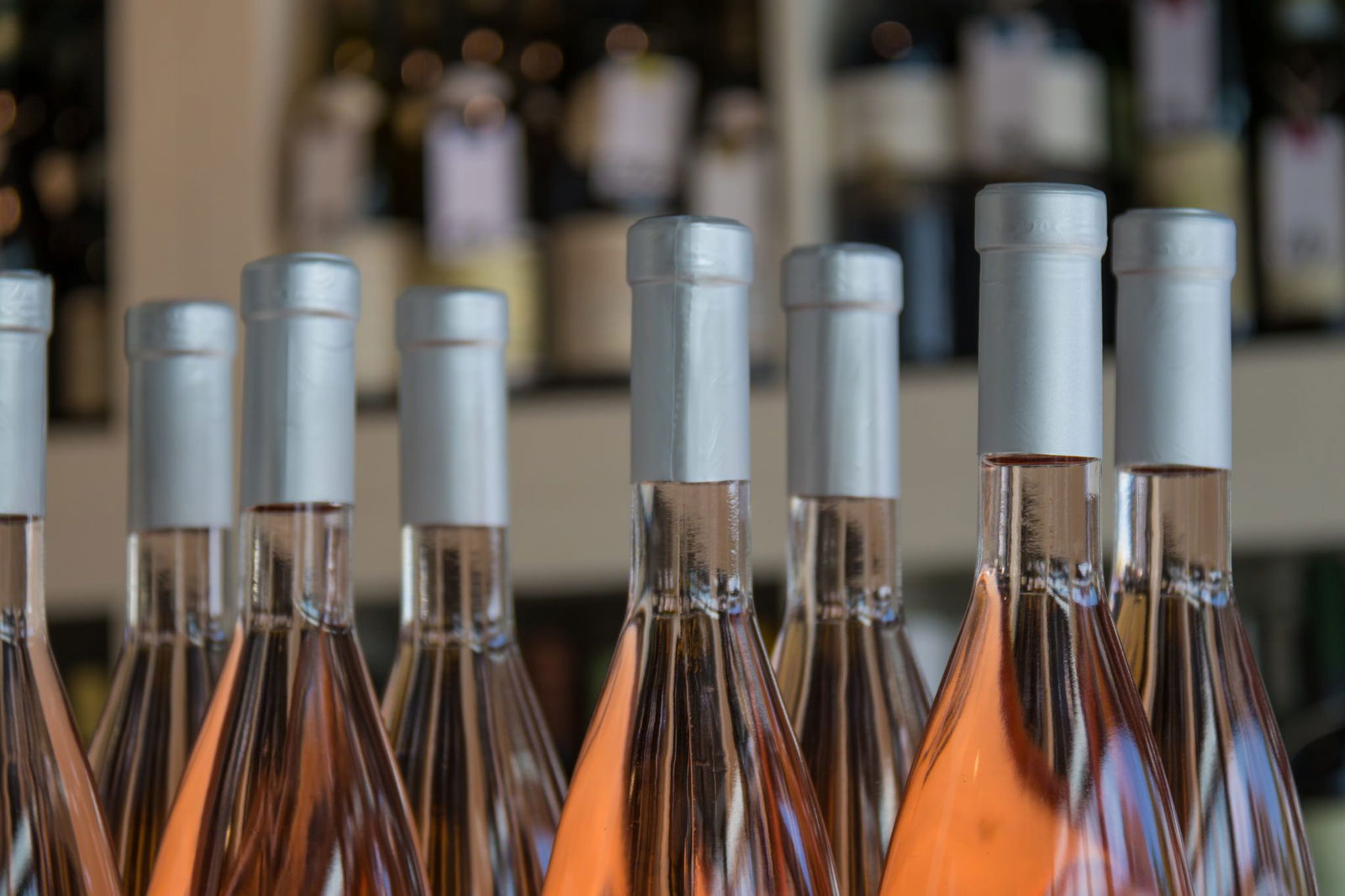
The color of rosé. Image: Flickr / Susanne Nilsson
Rosé flavor profiles generally consist of hints of red fruit, flowers, citrus, and melon. Rosés also often have "crunchy" green flavors, which give the drink a finish that tastes similar to rhubarb or celery. Because rosé wines can be made with various red wine grape types, it's flavor profile is almost always different depending on product line and brand. Some of the best rosés include: La Chapelle Gordonne, Jean-Luc Colombo La Dame du Rouet, Ameztoi "Rubentis" Rosado Txakolina, Pascal Jolivet Sancerre Rosé, Channing Daughters Rosato di Cabernet FrancFORTIFIED WINES
Fortified wines, which are often referred to as dessert wines, have a higher alcohol content than other wines thanks to their being mixed with distilled spirits like brandy. Although, while grape brandy is most often the distilled spirit that's added, neutral spirits made from grapes, grain, sugar beets, or sugarcane are also sometimes used.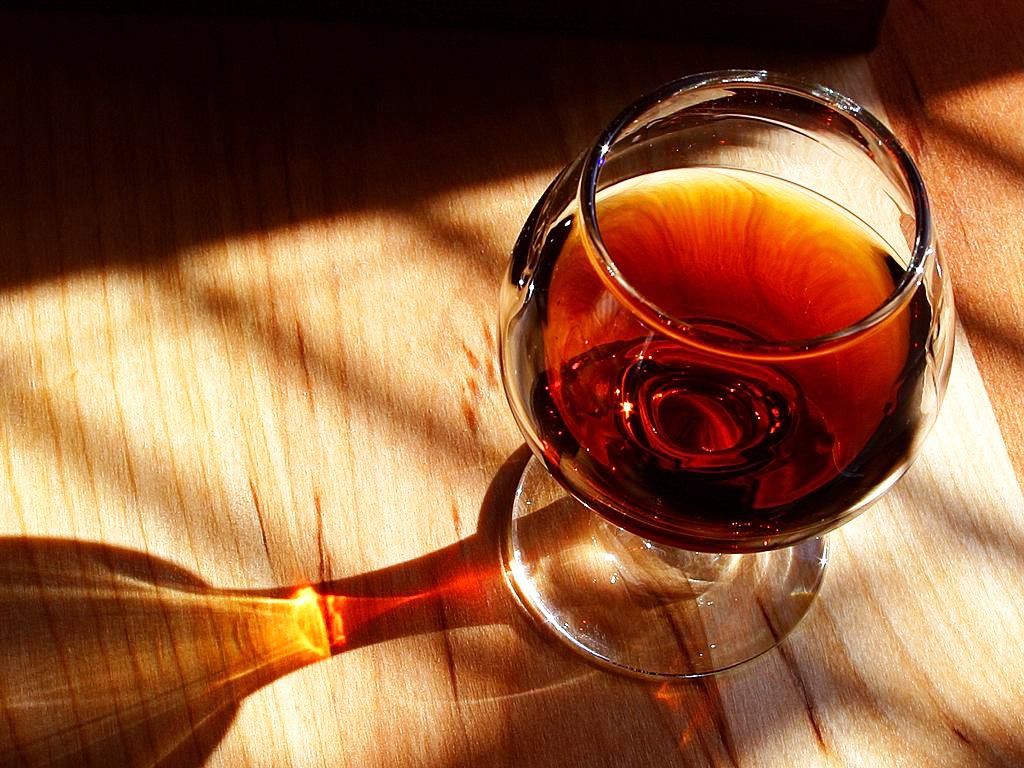
A glass of delicious port. Image: Wikimedia / Jon Sullivan
Fortified wine history side note: If you're wondering why exactly anybody would think to add a distilled spirit to some perfectly good wine, that traces back to the 18th century when winemakers wanted to figure out a way to fortify wine against going bad on long seafaring voyages. By adding a distilled spirit like brandy, the wine was much less likely to go bad in their not-so-airtight casks as it was protected against oxidation.COMMANDARIA WINE
Commandaria is a sweet, amber-colored dessert wine that's made in Cypress, an island country in the Eastern Mediterranean. Commandaria is made from sun-dried wine grapes that have an especially high sugar content thanks to their being picked ripe or even overripe, and is often combined with a 95% grape alcohol or wine distillate of at least 70% in order to up its ABV percentage to somewhere in the neighborhood of 15 to 20%. Note that because Commandaria can hit that ABV percentage without any distilled additives, it's not always fortified. Some of the best Commandaria wines include: "Anama Concept" Commandaria, KEO St. John Commandaria 1984, Legacy 2000 Commandaria, Lambouri Commandaria, St. Nicholas 2000 ETKO, Saint Barnabas SODAP.MADEIRA WINE
Madeira wine, which is usually served chilled with starter dishes or as an after-dinner digestif, is a fortified wine made in the Madeira Islands off the coast of Africa. Madeira wines are available in a range from very dry to very sweet, and, flavor-wise, usually exhibit notes of caramel, walnut oil, peach, hazelnut, burnt sugar, and orange peel.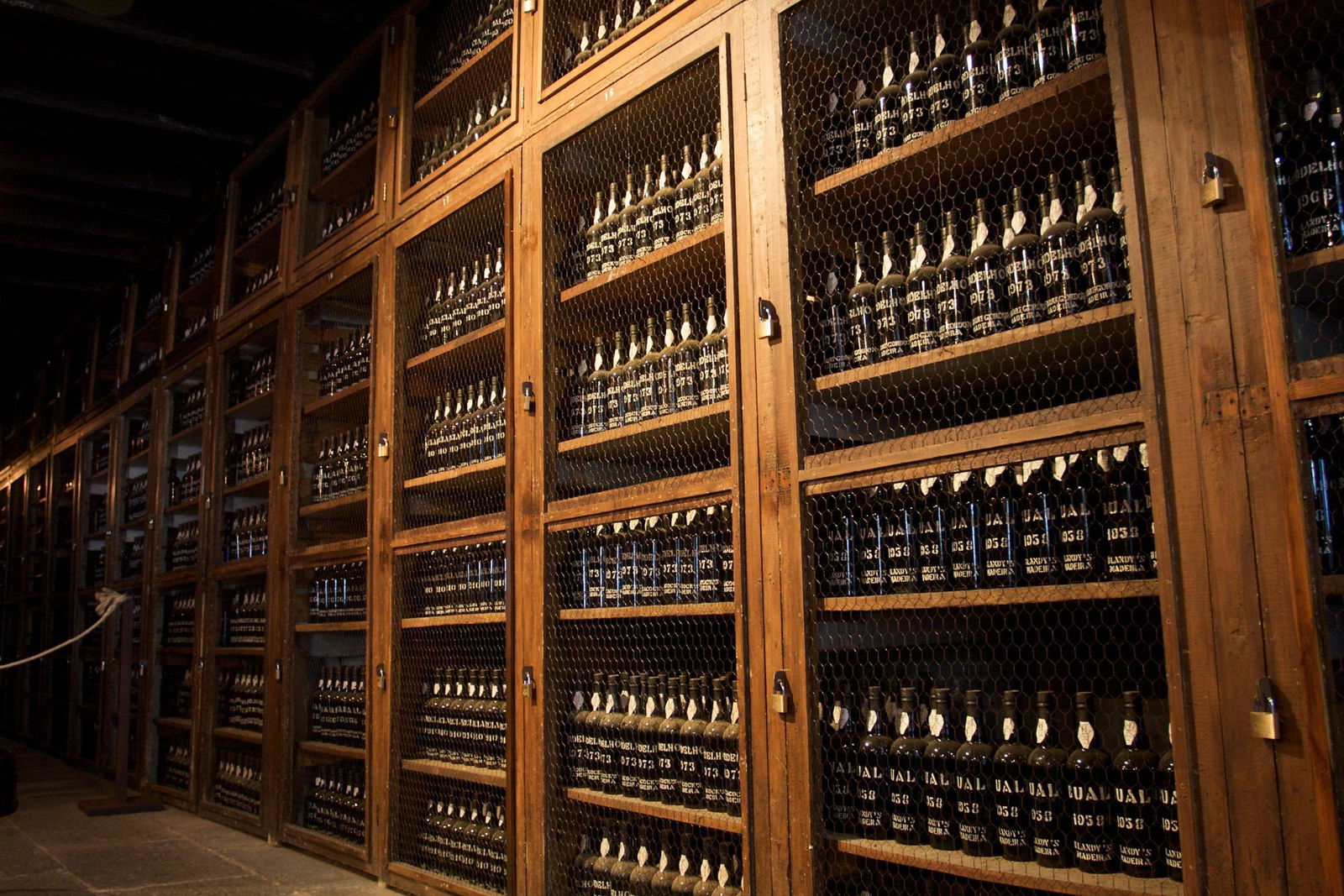
A tall wall of Madeira wine. Image: Wikimedia / Richard Gray
Some of the best Madeira wines include: HM Borges, Verdelho, 20 Year Old; Barbeito Frasqueira 1982, Henriques & Henriques; Bual, 15 Year Old, D'Olviveira, Colheita Terrantez 1988; Barbeito, Rainwater Reserva Medium Dry, 5 Year OldMARSALA WINE
Marsala wine is a fortified wine made in the Italian city of Marsala in Sicily. It is traditionally served as an aperitif — a drink served before a meal to boost appetite — and is often paired with whole fruits, spicy cheeses, or pastries. Marsala wines are also often used as cooking wines, especially in Italian dishes like chicken marsala. Flavor-wise, you can expect a profile made up of notes of cherry, apple, dried fruits, honey, tobacco, walnut, and licorice. Side note: marsala wines that don't come from Sicily are not genuine marsala wines! Some of the best marsala wines include: Vito Curatolo Arini Marsala Superiore Riserva Storica 1988, DOC; Vito Curatolo Arini Marsala Riserva Superiore, Dry, DOC; Pellegrino Cantine Cremovo Cream Fino, DOC; Marco de Bartoli Vignas la Miccia, Marsala Superiore Oro, DOC; Cantine Pellegrino Vino Marsala Vergine Riserva Annata 1962 Dry, DOCMISTELLE
Mistelle is a combination of unfermented fruit juice and distilled spirit that's often served as an aperitif in France. Some of the best Mistelle wines include: Michel Jodoin Mistelle Et Boule de Pomme, Copper & Kings Destillare Fortified & Infusted Mistelle, Bremerton Mistelle Fortified Chardonnay NV Langhorne Creek MistellePORT WINE
Port is a fortified wine produced exclusively in the nothern provinces of Portugal. It is usually sweet, and thusly served as a dessert wine, although it is also often dry or semi-dry in terms of mouthfeel and can also work as an aperitif or even, in some instances, a drink served with a meal. Other fortified wines labeled "port" are made outside of Portugal, but they are not recognized as true, genuine port. As a general note on port wines, they're generally associated with a kind of bourgeoisie lifestyle — it's the kind of drink that's often enjoyed along side a fine cigar by the aristocratic elite. So if you're looking to feel real fancy, this is the drink for you.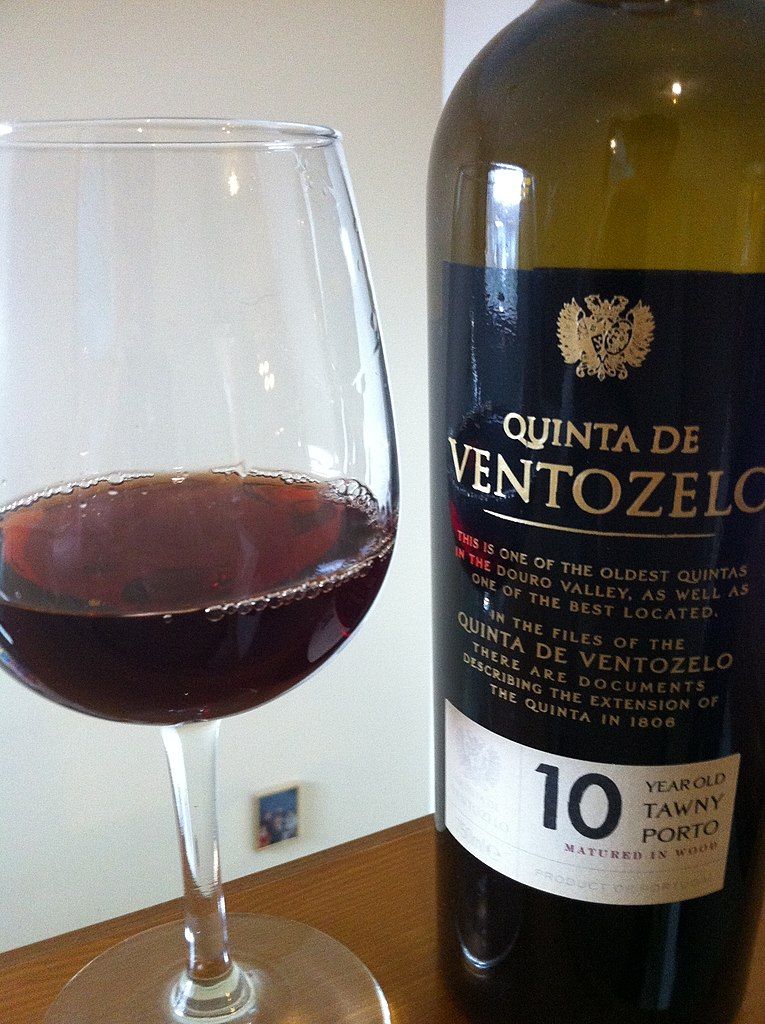
A fine Portuguese Port wine. Image: Wikimedia / Agne27
Some of the best port wines include: Taylor's Vintage Port 1985, Warre's Vintage Port 2000, Quinta Do Noval Nacional Vintage Port 1985, Graham's Vintage Port 2003, Fonseca Guimaraens 1998SHERRY
Sherry is fortified with brandy and made exclusively in the city of Jerez de la Frontera in Andalusia, Spain. Most sherry wines are aged in a solera system, which mixes different vintages to make sure the final product has a consistent flavor profile and quality. (The solera system works by stacking barrels and having the oldest vintages move their way down to the bottom barrel while younger vintages are poured in after; the youngest sherry that'll ever enter your mouth will be at least three years old.) Some of the best sherry wines include: Bodegas Hidalgo La Gitana Manzanilla Sherry, Tesco Finest Oloroso Sherry, Bodegas Ximémez-Spínola Este Pedro Ximenez, NV Bodegas Hidalgo "La Gitana" Manzanilla en Rama, NV Valdespino "Tio Diego" AmontilladoVERMOUTH
Vermouth is a fortified wine that's flavored with various botanicals including barks, seeds, herbs, roots, flowers, and spices and usually drunk as an aperitif. Vermouth is produced mainly in France and Italy, and aside from being drunk as an aperitif is most often used as a mixer in cocktails such as the Martini, the Manhattan, the Rob Roy, and the Negroni. Vermouth is historically offered as either sweet or dry, although there are also extra-dry white, sweet white, red, amber, and rosé categories as well.
A Negroni; a cocktail that calls for vermouth in the recipe. Image: Flickr / N Wong
Some of the best vermouth wines include:Antique Carpano Punt e Mes, Noilly Pratt Original Dry, Ransom Dry Vermouth, Marks & Spencer Vermouth Blanc, Cocchi Vermouth di TorinoGWAHA-JU
Gwaha-ju is a traditional Korean fortified wine that's made from fermented rice and the distilled spirit, soju, with the addition of ingredients like dried ginseng, steamed jujubes, and ginger juice. Although gwaha-ju isn't made from a grape-based wine, it's still usually placed in the fortified wine category. Note that there are various types of gwaha-ju, and an individual flavor profile will depend on the type of gwaha-ju.OLD WORLD VERSUS NEW WORLD WINES
One other important distinction you'll want to know about in order to pass yourself off as a true wine connoisseur is the difference between Old World wines and New World wines. As the two categories suggest, Old World wines refer to wines that have been made in countries that are considered the birthplaces of wine, mainly including those located in the Middle East and Europe. Old World wine-producing countries include France, Italy, Spain, Portugal, Germany, Greece, Austria, Lebanon, Israel, Romania, George, Croatia, Switzerland, and Hungary. New World wines are — duh once again — made in the New World. New World wine-producing wine countries include New Zealand, the U.S., Argentina, Chile, Australia, and South Africa.
Bottles of wine from New Zealand. Note that country of origin is listed on the bottle. Flickr / Salman Javed
As far the differences in production process and flavor profile between the two categories, they are as follows: Old World wines: Old World winemaking is heavily restricted with enforced guidelines that wineries must adhere to. Almost all Old World wines have also been using the same wine production methods for generations and have storied lineages. They tend to be lighter-bodied, lower in alcohol content, and exhibit more floral, earth, mineral, and herb flavors. New World wines: New World wines come from warmer climates, which tend to produce riper, more full-bodied, more fruit-centered, more alcoholic wines. New World wines obviously don't have lineages that are nearly as extensive as those of Old World wines due to the fact that they simply haven't been produced in the New World for nearly as long. As a general note, there's no real way to say if one type of wine or the other is better. Anybody who says they prefer one type over the other is just giving you their subjective opinion.COMMON WINE TERMS TO LOOK OUT FOR
Here is a short (very incomplete, but nonetheless useful) list of wine terms that you'll see pop up over and over again on your journey to becoming a true wine connoisseur. Fruit Forward: "Fruit forward" refers to a wine flavor profile that tastes heavily of fruit; usually sweet fruits such as cherries, raspberries, blackberries, or gooseberries. https://giphy.com/embed/xUPGcharQ0qazfM3qo Tannins: Tannins, which are organic compounds that exist inside grape skins, stems, and seeds, are what causes the "dry mouth" feeling when drinking a red wine. Tannins cause this effect because they are astringent: i.e. they tend to shrink body tissues. Fun side note: Tannins are used by plants as a defense mechanism. So if you're wondering why sometimes a really dry wine is kinda rough on the palate, there's your answer. Earthy: Used to describe flavors such as clove, beeswax, chalk, spice, cured meats, and chocolates. https://giphy.com/embed/2uwXWPBTzblqRlKCvT Finish: The "finish" of a wine refers to the flavors left in your mouth after you've swallowed a sip. Typicity: Typicity (sometimes referred to as "typicality") is a reference to how typical a wine tastes for the region from which it comes. Typicity is important because it can help you to know that if you continue to get a certain wine from a certain region, you'll be able to expect the same quality. Medium-Bodied, Light-Bodied, Full-Bodied: When people talk about a wine's "body," it's a reference to a particular wine's weight on your palate — wines with high alcohol levels or high sweetness are often considered to be full-bodied, while wine's lower in alcohol content are referred to as light-bodied. Medium-bodied wines, are, of course, wines that fall somewhere in between. (The reason alcohol affects a wine's "body" is because it is more viscous than water.)
A fine full-bodied wine. Image: Wikimedia / Nonnoant
Dry: In the wine world "dry" means the opposite of sweet flavored. So the more dry a wine is, the less sweet it tastes. "Off-dry" references a wine that is only a little bit sweet. Complexity: Complexity is probably the most subjective and nebulous term when it comes to wine descriptors. Basically, discussing a wine's "complexity" is a discussion of its quality, its range of flavors, and even its lineage. The more interesting each one of these factors is for a given wine — the wider the range of flavors in a given profile, for example — the more complexity it is said to have. Varietal: A varietal wine is one made completely or almost completely from a single grape variety. For example, a Cabernet sauvignon made from Cabernet sauvignon grapes. You'll only have a bottle of "varietal" wine if it's made principally from a single variety of grape, if the bottle of wine is made from a blend of varieties and labeled as such, it is not a varietal. Bouquet: A wine's bouquet is a reference to the range of aromas it offers. This term is used especially in the case of mature wines. Astringent: How "astringent" a wine is a measurement of how much of a dry, puckering feeling it causes in one's mouth. Texture: A wine's "texture," is a reference to the tactile sensations felt in the mouth. For example, a wine's texture could be described with words like oily, waxy, silky, juicy, velvety, etc. Aeration: Aeration is literally the process by which air is circulated through, mixed with, or dissolved in a liquid or substance — so in the case of wine, you're just talking about getting some air in it. If you hear somebody talking about letting a wine "breathe," this is what they're talking about. https://giphy.com/embed/Z7l70CTiJuzNS Balance: A wine's "balance" is a reference to how well its different components work together. For example, a wine is considered to be "balanced" if it's not too alcoholic, too acidic, too sweet, or too fruity. If any one of these factors sticks out, then the wine is said to be poorly balanced. Terroir: The complete natural environment in which a particular wine is produced, including factors such as the soil, topography, and climate. Sommelier:A trained and knowledgeable wine professional, normally working in fine restaurants, who specializes in all aspects of wine service as well as wine and food pairingHOW TO DRINK WINE
All of you novitiate connoisseurs now know what wine is, where wine comes from, how wine's made, and most of the major wine categories and types out there, which means it's finally time to get to the fun part: how to drink wine. And yes, while drinking wine is definitely one of the most pleasurable alcohol-related activities out there, doing it "properly" involves a lot of guidelines. But having a bunch of guidelines doesn't necessarily mean drinking wine properly is a hassle. In fact, if you really get into it, it can be a lot of fun to act like — or actually become — a genuine wine snob. Not only is it fun to act the part, but you'll also be able to correct anybody around you who's drinking wine "incorrectly."HOW TO READ WINE LABELS (OLD WORLD WINES, APPELLATION SYSTEM)
When it comes to properly drinking wine, the first thing you'll need to know is how to read a wine bottle label. With that in mind, here are a bunch of tips — for both Old World wines and New World wines — that'll help you to pick out the perfect bottle for you.CHECK COUNTRY OF ORIGIN / SPECIFIC REGION OF ORIGIN OF THE WINE
If you have a bottle of Old World wine in hand, the first piece of information you'll want to collect from the label is where the wine was made, both in terms of country of origin and region of origin — this is often referred to "appellation of origin." Finding out where in the world a wine was made will not only tell you if it is indeed an Old World wine, but it'll also give you more insight into the type of climate the wine's varietal comes from — this is important because different climates will often churn out different types of wine. For example, wine vintages from warmer climates are often weightier and fruitier. A French wine label. The Appellation lists Bourgogne, a region of France. Image: Flickr / Rictor Norton & David Allen
Note that, in general, the more specific a bottle wine gets with the description of its origin, the more likely it is a high-quality bottle of wine. For example, a wine that comes from a specific subregion of Mulhouse, Alsace in France is likely to be a better wine than one that simply comes from Alsace. If a wine label takes it the next level in terms of specificity and notes which estate produced the wine, that means that at least 95% of the grapes used to make the wine came from the named vineyard.
Also note that much of the time Old World wines will only list regional origin of the wine, not what types of grapes were used to make the wine.
A French wine label. The Appellation lists Bourgogne, a region of France. Image: Flickr / Rictor Norton & David Allen
Note that, in general, the more specific a bottle wine gets with the description of its origin, the more likely it is a high-quality bottle of wine. For example, a wine that comes from a specific subregion of Mulhouse, Alsace in France is likely to be a better wine than one that simply comes from Alsace. If a wine label takes it the next level in terms of specificity and notes which estate produced the wine, that means that at least 95% of the grapes used to make the wine came from the named vineyard.
Also note that much of the time Old World wines will only list regional origin of the wine, not what types of grapes were used to make the wine.
CHECK THE QUALITY DESIGNATION
Because so many Old World wines are strictly regulated by the governments in their countries of origin, designations of quality can be very helpful when trying to figure out exactly how fancy the bottle of wine in your hand is. Some examples of the quality designations you'll see on Old World wine bottles — listed from lowest to highest quality – are given below: Portugal: Portugal has only one quality designation, "Denomination of Controlled Origin" (DO), which is used to indicate that a particular wine is indeed of high quality. France: Vins de Table (table wine), Vins de Pays (country wine), wines of superior quality (VDQS), Appellation of controlled origin (AOC). Spain: Denomination of Qualified Origin (DOC), Denomination of Origin (DO). Germany: Deutscher Tafelwein (simple table wine), Deutscher Landwein (superior table wine), QBA (quality wine from a specific appellation), QWSA (quality wine with special attributes). Italy: Vini di Tavola (table wine), IGT (typical geographical indication), denomination of controlled origin (DOC), denomination of controlled and guaranteed origin (DOCG).WITH VINTAGE WINES, LOOK FOR THE YEAR MADE
If you have a bottle of vintage wine in your hand, it's going to have a year printed on it — that's the year the grapes used to make the wine were harvested. In terms of American vintage wines, federal law states that in order for a wine to be considered "vintage," 85% of its grapes must come from the same harvest in the same location. Note that restrictions are tighter for wines that labeled with the letters AVA — which stands for American viticultural area. If an American vintage wine is labeled AVA that means 95% of the grapes used to make it come from the same harvest in the same location.PAY ATTENTION TO THE SHAPE OF THE WINE BOTTLE
When it comes to Old World wines, the shape of the wine bottle can provide you with a surprisingly amount of pertinent information. Here are some of the following bottle shapes that can tell you a lot about the wine they contain: Bordeaux wines are often found in straight, high-shouldered bottles. These types of wine bottles will use green glass for red wines and clear glass for white wines.
A sampling of Bordeaux wines. Image: Flickr / filtran
Wines from Burgundy, Loire, and Rhone — all located in France — most often use gently-shouldered bottles. If this type of bottle is used for anything besides a French wine, then it most likely contains Chardonnay or Pinot noir. Wines from Germany and Alsace are usually found in tall, slender bottles. These types of bottles from Germany and Alsace usually contain Pinot blanc, Pinot gris, Riesling, or the German dessert wine, Gewurztraminer.HOW TO READ WINE LABELS (NEW WORLD WINES, VARIETAL SYSTEM)
CHECK COUNTRY OF ORIGIN
New World wines — those produced in countries like New Zealand, the U.S., Argentina, Chile, Australia, and South Africa — are almost always identified by a country of origin on their labels. This is a broad yet important place to start when analyzing a New World wine, as it will give you the most general sense of what to expect from the wine. (Different countries have different climates and will therefore produce different wine flavors even if the same varieties are used.)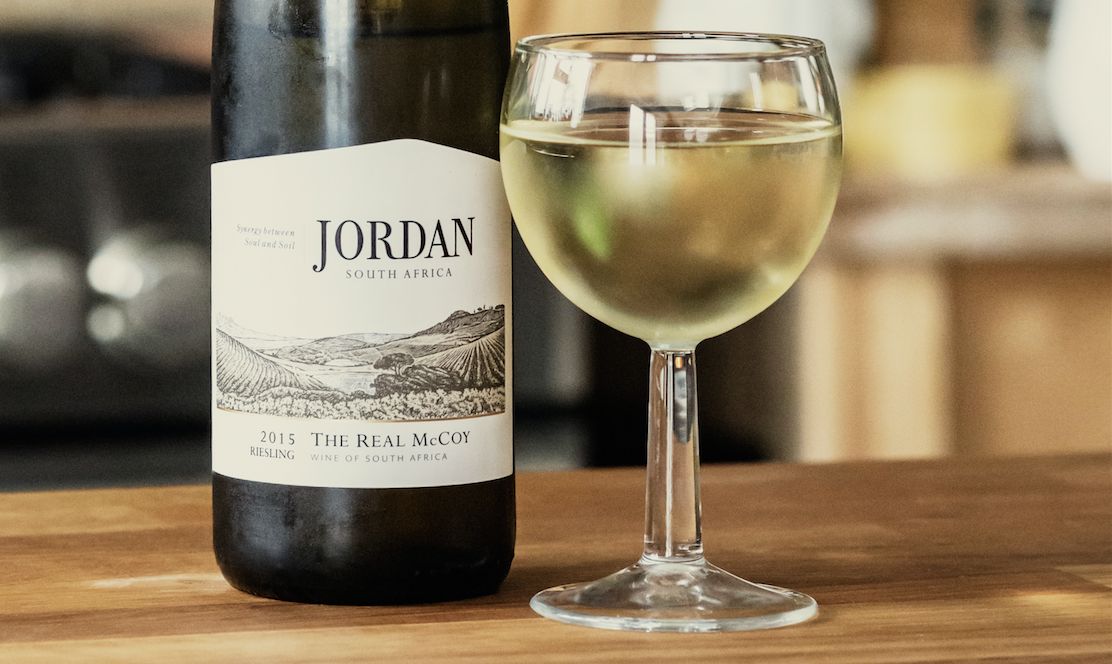
A bottle of wine from South Africa. Note country of origin is listed. Image: Flickr / brett jordan
Side note: If you see the phrase "produced and bottled by..." followed by a specific location, that means that the location listed produced and bottled the wine. You'll often see this phrase used by a particular winery that has produced and bottled its own wine. If you see the phrase "cellared or blended" that means that the wine you're about to drink was not produced at the winery that bottled it.CHECK BRAND NAME AND PRODUCTION DATE
When it comes to New World wines, the brand name on the bottle is also the name of the vineyard which produced the wine. Vintage wines — those made from single harvest — will be identified by the year they were produced. This is important because it can potentially reveal the quality of the wine, as well as how old the wine is.CHECK TYPE OF GRAPE AND VINEYARD
If a wine bottle is labeled with something like Chardonnay, Merlot, Syrah, Pinot grigio, or Sauvignon blanc, that means that the wine in the bottle was made with at least 75% of the grape type listed (remember that Chardonnay, Merlot, etc. are references to a type of grape). New World wines will also often list the vineyard that produced the varietal used to make the wine in the bottle.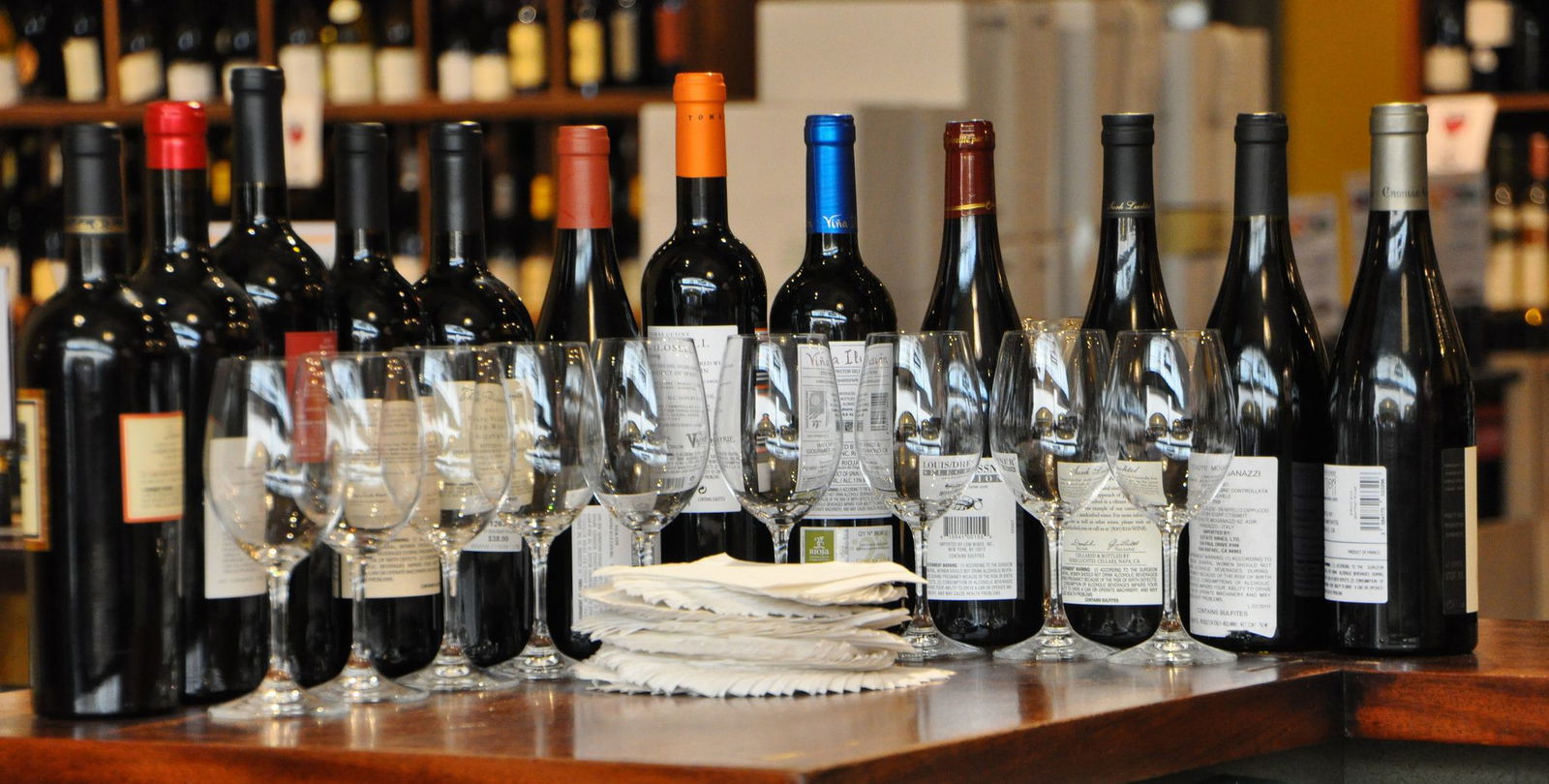
Various bottles of wine from California. Image: Flickr / Ted
Side note: The main reason New World wines prefer to emphasize varietal over location is because Old World wines often have respected, trusted lineages attached to certain wineries in certain locations while New World wines don't.HOW TO SAMPLE WINE
Are you still with us people?! Is your brain completely wined out? Are you ready to just start whining about wine like a little French baby? Well, all your hard work reading over this guide is about to pay off, 'cause we're now going to get into the part where you actually get some wine in your mouth! To get said wine in your mouth the "proper" way — and to enjoy it to the max — you'll want to follow the steps listed below.LOOK / SWIRL
First up, before a drop of wine touches your tongue or a whiff of bouquet invades your nose, you'll want to enjoy your wine by first taking it in with your eyes. In order to do this, you'll want to start with a clear wine glass. Once you have your clean and clear wine glass, go ahead and pour a little wine into it — about an inch or less should do. Once you've poured your wine, it's time to do a full visual rundown. You'll want to look at the wine from both the top and from the side, as each angle will give you different information about the wine you're about to sip. Looking down on the wine from the top of the glass will give you clues as to how dense the wine is — the darker the color, the higher the density (density here referring to concentration of alcohol, sugar, dissolved solids, etc.). A side view of the wine can give you insight into how clear or murky it is, which is often an indicator of how filtered a wine is, or if there is sediment buildup from being shaken up too much.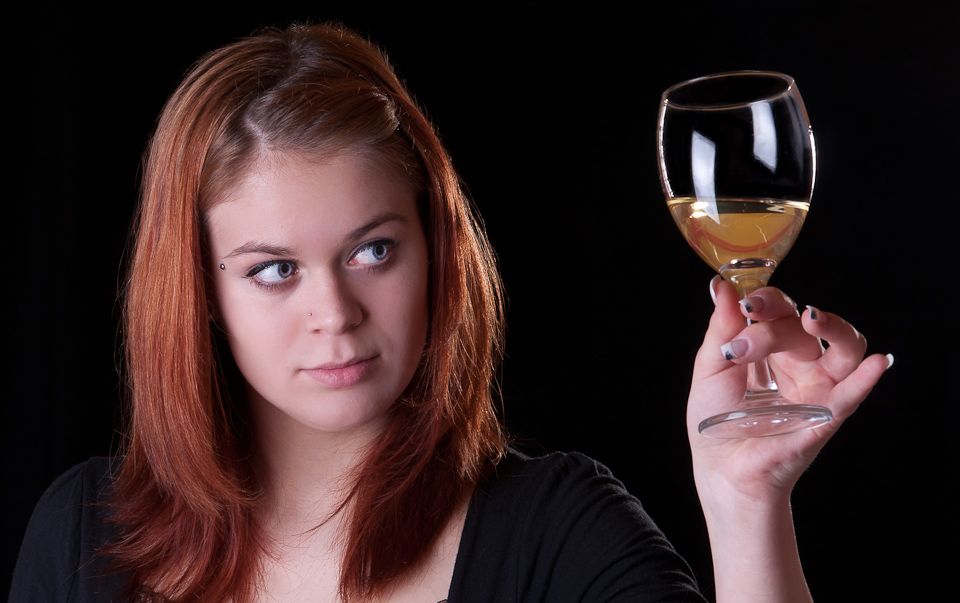
Checking out the wine. Image: Wikimedia / multimotyl
Looking at the wine in the glass can also give you clues as to how old the wine is — white wines will gain color as they age whereas red wines will lose color. So if your white wine is more of a dull, faded, yellow than a bright, sparkling clear/light yellow, it's definitely been around the block. Conversely, if your red wine is fading into more of an orange, pink, or peach color, then it is likely to be pretty old. Once you've checked out the wine in the glass with your peepers, go ahead and swirl it around a bit (without spilling...). Swirling will not only aerate the wine (infuse it with some extra oxygen), but will also allow you to analyze the "legs" or "tears" that the wine forms — the legs (or tears) are the streaks of liquid that form on the inside of the glass as the wine is swirled. The longer and more noticeable the legs, the higher the alcohol and glycerin content of the wine; this translates to ripeness and mouthfeel.SMELL
Once you've drunk in the wine with your eyes, it's time to sniff it up with your nose. But don't go in there like a nosy Rambo, you want to keep it cool, like a nasal-ish James Bond. Start your little tour of smells by hovering your nose a few inches above the wine glass's opening for just a few moments then taking it away. After you've caught a whiff of your wine, meditate on it for a few moments and try to describe the different aromas you notice. Don't worry about describing every aroma you can smell though — great wines often offer hundreds of different aromas, so it's basically impossible to describe them all. Besides, who has time for that when there's wine to drink? https://giphy.com/embed/402YwTOnEUcUuq4MoQ In general, the aromas you'll want to look for are those that are characteristic of the varietal you're drinking. For example, a Pinot noir will likely exhibit a bouquet of cherries, raspberries, and strawberries. You'll also be looking for "earthy" aromas as well as "herbal" and "floral" aromas. Earthy aromas are those like leather, mushroom, or even rocks, and can be indicative of the terroir from which the wine's grapes were harvested. Floral aromas, such as lavender, violet, rose, and citrus blossom are common to varietals grown in cool climates and can again help you to pinpoint possible source terroirs. On top of fruity, floral, and herbal aromas, you may also smell aromas that come from the barrel aging process. These aromas will usually include honey, vanilla, roasted nuts, caramel, toast, chocolate, smoke, or even beer. https://giphy.com/embed/KyIb3qvpa4HSkLpmHK Finally, smelling a wine can actually help you to determine whether it's worth drinking at all. For example, if you're getting hints of wet newspaper or musty old attic, that could indicate that the wine has gone bad and should not be drunk. Likewise the smell of vinegar or nail polish can also signal the wine is not worth drinking — although if the smell is very faint, it's probably not a problem.TASTE (SUCK, SWISH, SWALLOW AND/OR SPIT)
Yes, people, yes!!! It's finally time to actually drink some dang wine. But to do it like a true connoisseur, you're going to need to describe what you're tasting after you're done tasting it — again, this sounds snooty, but once you start getting good at it can be a very fun little game to play. https://giphy.com/embed/3o6nVbOdgmmtC93IhW When you sip (and it really is just a sip) the wine, pretend as if you're sucking it into your mouth through a straw. So you'll want to put your lips on the rim of the glass, tilt the glass, and literally suck a little of the wine into your mouth. Once you have the wine in your mouth, on your tongue, you'll want to start analyzing its flavor profile — is it fruity? If so, what fruits does it taste like? Is it dry? If so, how dry? Etc. etc. But you won't only be identifying the flavor notes of the wine however, you'll also be figuring out how "complete" or "complex" the wine is. According to most experts, the completeness of a wine is a measurement of how balanced and satisfying it is. In other words how well all of the wine's various components work together. A complete wine will not be too fruity, too dry, too astringent, or too sweet, but rather a perfect blend of each and every flavor and mouthfeel. Complexity is a measurement of how well a given wine "dances" on your palate — in other words how much the wine's various flavors change over time, even after you've spat or swallowed your sip. https://giphy.com/embed/xT1R9VwEbCTUoXJeRG In terms of the logistics, you'll want to let the wine rest (and/or swish around) in your mouth for roughly 10 seconds before spitting or swallowing. And while spitting may seem rude, it's commonplace when it comes to tasting various wines in a single setting — in fact, if you go on a winery tour or even just visit a high-end wine market, professionals will usually give you a spit bucket in which you can spit out your sips. Spitting is commonplace because it not only readies your palate for the next wine, but also helps you to not get wasted too quickly; that can, of course, inhibit your ability to properly judge a wine. Side note: If you're tasting a handful of wines — say if you're trying out a flight — you'll probably want to start with the lightest wines (like rosés, rieslings, etc.) and move your way up to the heavier ones (like Pinot noir, red moscato, etc.). This will allow you to keep your tastebuds from being overwhelmed as you continue to taste different wines. A sip of water between each type of wine you're trying will also help to cleanse your palate.PAIRINGS (CHEESES, MEATS, CHOCOLATES, ETC.)
Another gigantic part of properly drinking wine is eating — no, not the wine, the food you'll eat along with the wine. But if you're going to pair wine with food like a genuine snob-a-rello, you can't just eat any cheese or meat or pasta with any type of red wine — no, no, as with everything else related to drinking wine, there are a ton of guidelines you'll want to take into account. And while taste is, of course, entirely subjective, the pairings listed below are recommended by experts and people with a lot experience in this area, so you'll probably find that following these matchups will indeed deliver the best taste experience.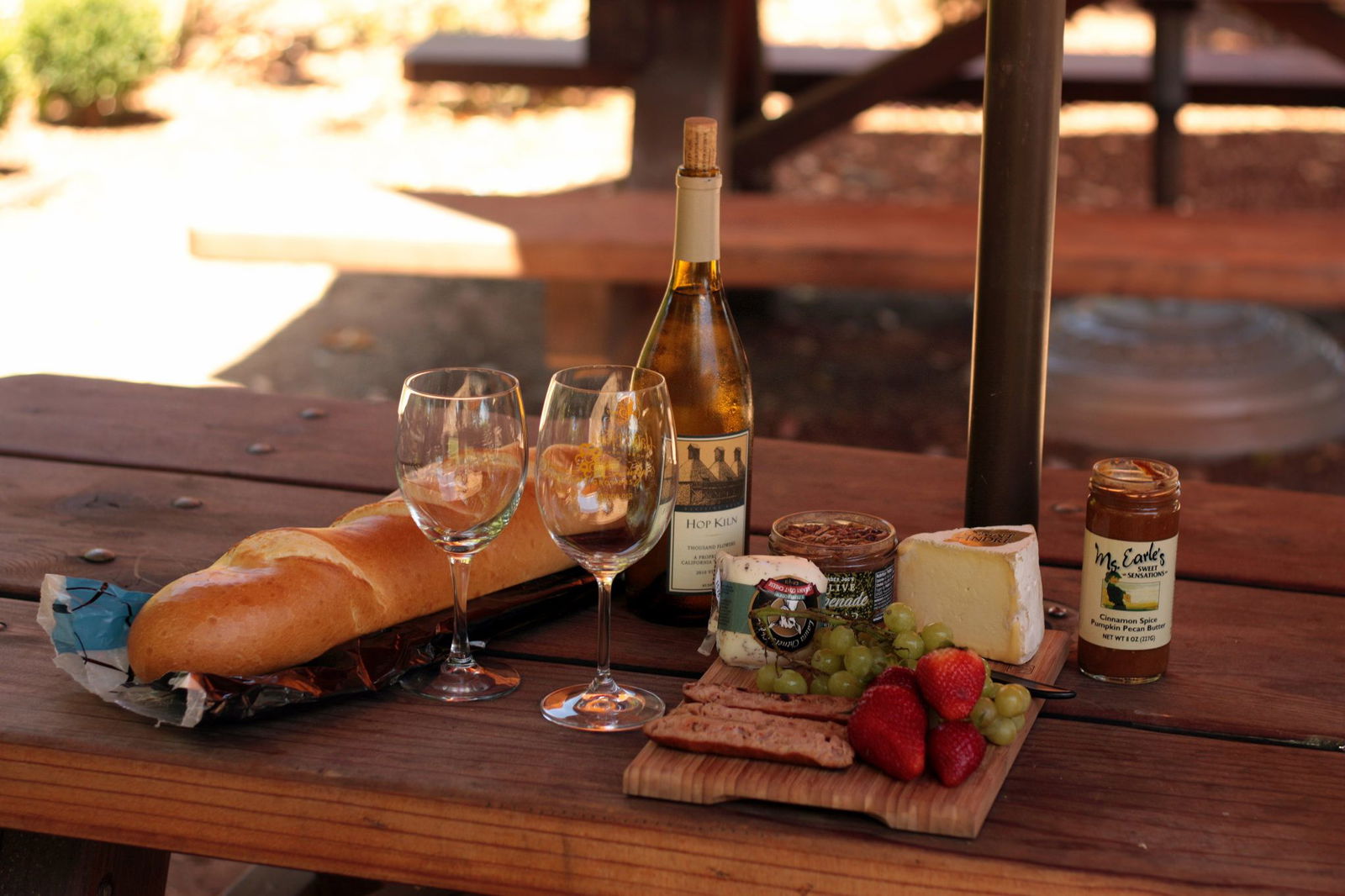
Some foods for pairing. Image: Flickr / Sean Freese
GENERAL PAIRING GUIDELINES
1. Match the wine with the sauce, not necessarily the meat: In general, red wines with red sauces, and white wines with white sauces. (There are plenty of exceptions to these rules though.) 2. Pair earthy wines with earthy foods: If you're having an earthy meal, something with a lot of vegetables and mushrooms and garlic, go with an earthy wine like a barrel-aged Pinot noir. 3. Light wines work well with hors d'oeuvres: Serving some finger foods? They'll pair perfectly with something like a nice, dry rosé. 4. Pair salty foods with sweet wines: Having some salty pork? Or maybe a fried rice dish with lots of soy sauce? Grab yourself a sweet wine like a fruity Pinot grigio or even a Moscato if you're that brave. 5. Fruity wines work well with fruity dishes: If you're having a dish with figs or glazed apricots or sautéed apples or any other fancily made fruit, grab yourself a fruity wine like a riesling or Gewürztraminer. 6. Pair red wines with red meats: Got yourself a steak or some buffalo meat or some pork? Drink it with a red wine! 7. Pair bold foods with bold wines, subtle foods with subtle wines: Pair a bold wine like a Cabernet Sauvignon with a curry dish, pair a more subtle wine like a Chardonnay with a simple salmon dish. 8. White wines pair best with light meats: Self explanatory, yeah? If you're having some chicken or some turkey, grab yourself a nice Pinot grigio, Chardonnay, or other delicious white wine. 9. The wine should be more acidic than the food: Acidic wines (like a Riesling) work well with fatty and sweet foods. In general, fatty foods should be paired with an acidic wine (or at least a wine with a fairly high ABV). 10. Pair pricey with pricey and cheap with cheap: If you're having a meal from Burger King, maybe just go with a bottle of Barefoot, ya dig? 11. Pair desserts with lighter wines: If you're busting out with the cookies, cakes, and ice cream, go with a nice light Syrah or Pinot grigio.PAIRING WINES WITH CHEESES
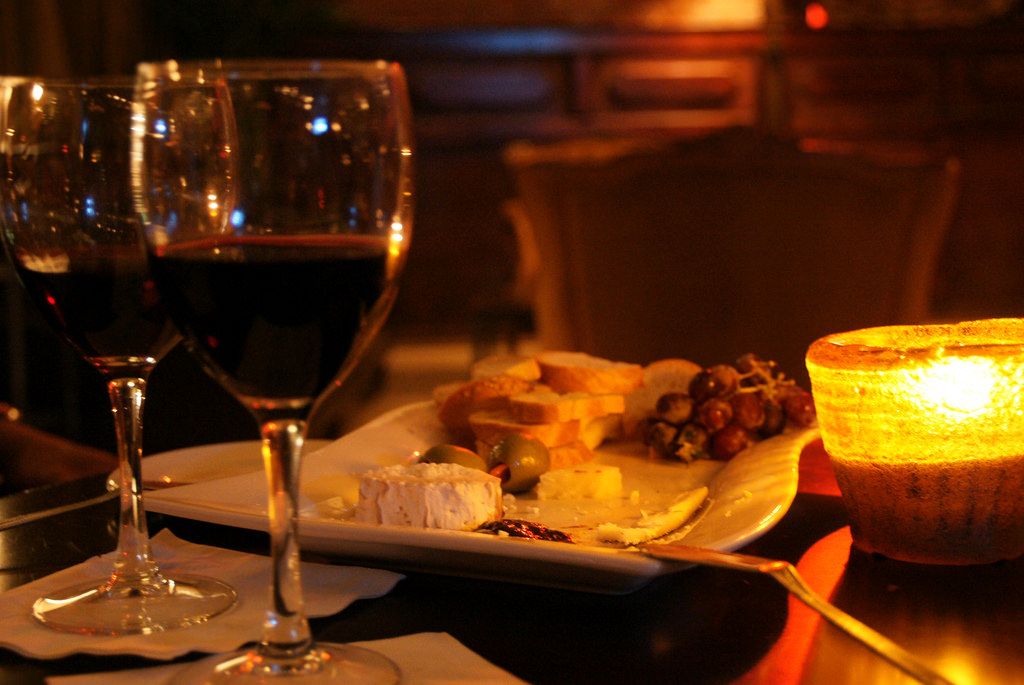
Wine and cheese. Image: Flickr / Marcus Södervall
Brie — Chardonnay (white), Merlot (red) Gruyere — Sauvignon blanc (white), Zinfandel (red) Gouda — Merlot (red), Shiraz (red), Pinot grigio (white), Riesling (white) Roquefort — Riesling (white), Cabernet sauvignon (red), moscato (fortified) Cheddar — Cabernet sauvignon (red), Malbec (red, for sharp cheddar) Ricotta — Pinot grigio (white), Port (fortified wine) Parmesan — Chianti (red), Aglianico (red) Mozzarella — Sauvignon blanc (white), Verdicchio (white), Champagne Swiss — Pinot noir (red), Merlot (red), Gewürztraminer (red) Camembert — Champagne, Merlot (red), Cabernet sauvignon (red) Ricotta — Pinot grigio (white)PAIRING WINES WITH PASTA
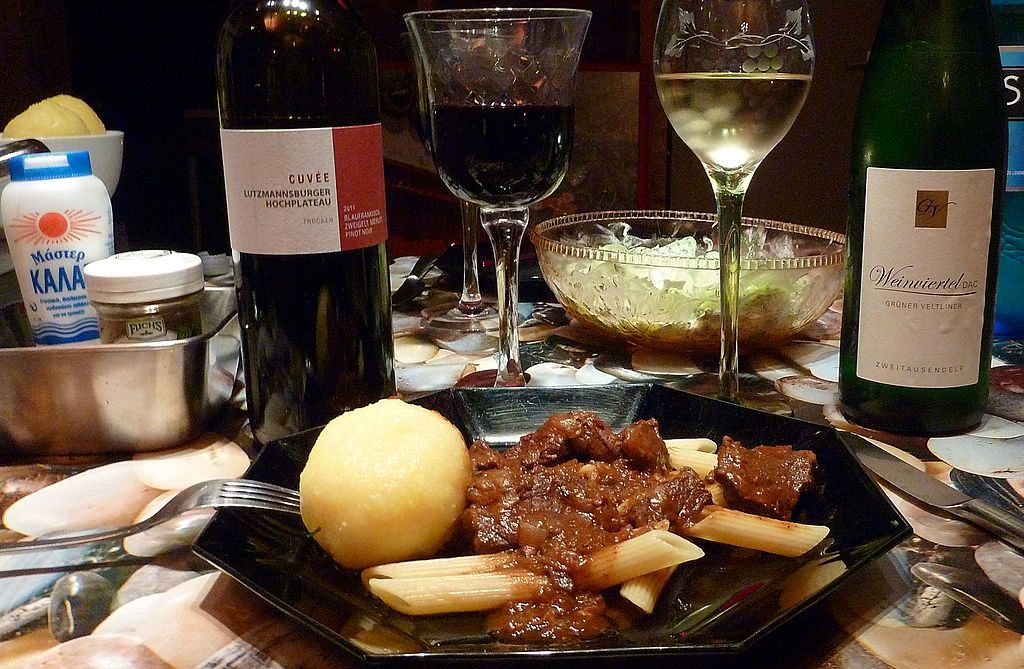
Wine and pasta. Image: Wikimedia / Manfred&Barbara Aulbach
Tomato-based pasta — Zinfandel (red), Cabernet sauvignon (red), Malbec (red) Cheese pasta — Chardonnay (white), Pinot noir (red), Malbec (red), Syrah (red) Seafood pasta — Pinot grigio (white), Chardonnay (white), Sauvignon blanc (white), Rosé Vegetable pasta — Chardonnay (white), Sauvignon blanc (white), Riesling (white) Pesto pasta — Sauvignon blanc (white), Chardonnay (white), Pinot noir (red), Syrah (red)PAIRING WINES WITH MEATS

Wine and meat. Image: Flickr / LenDog64
Chicken or turkey — Sauvignon blanc (white), Chardonnay (white), Rosé, chilled Pinot noir (red) Fish (like trout, salmon, etc.) — Sauvignon blanc (white), Chardonnay (white), Rosé, Cava (for trout) Beef — Zinfandel (red), Cabernet sauvignon (red), Pinot noir (red), Merlot (red), Shiraz (red) Lamb — Pinot noir (red), Cabernet sauvignon (red), Zinfandel (red) Veal — Sauvignon blanc (white), Riseling (white), Gewürztraminer (white) Pork — Chardonnay (white), Sauvignon blanc (white), Pinot noir (red) Cured meats (charcuterie) — Cava (white, sparkling), Champagne, Cabernet sauvignon (red)PAIRING WINES WITH PIZZA
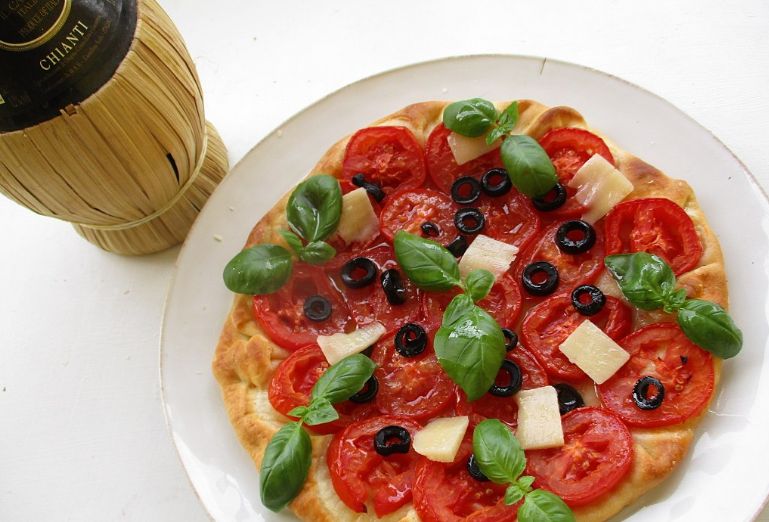
Wine and pizza. Image: Wikimedia / Arnaud 25
Cheese pizza — Pinot noir (red), Dolcetto (red), Pinot grigio (white) Pepperoni pizza — Shiraz (red), Sangiovese (red), Cabernet franc (red) Veggie pizza — Chardonnay (white), Sauvignon blanc (white), Verdejo (white) White sauce pizza — Champagne, Frappato (red), Chardonnay (white) Meat lover's pizza — Cabernet sauvignon (red), Syrah (red), Pinotage (red) Margherita pizza — Pinot grigio (white), Garnacha (red wine), Dry Rosé Hawaiian pizza — Riesling (white), Chardonnay (white), Pinot noir (red)PAIRING WINES WITH DESSERT

Wine and dessert. Image: Flickr / star5112
Champagne — bread pudding, tapioca, classic birthday cake, cheesecake, custard, tiramisu Chardonnay (white) — caramel candy, candy apples, chocolate pudding, butterscotch Pinot noir (red) — dark chocolate, chocolate pudding, cherry pie, raisin rolls, oatmeal raisin cookies Zinfandel (red) — chocolate cake, chocolate chip cookies, vanilla pecan pie, red velvet cheesecake, pecan fudge Riesling (white) — apple pie, custards, tarts, pumpkin pie, cheesecake, poached pear Sauvignon blanc (white) — sweet potato pie, cheese danish, passionfruit and mango-filled pavlova, macaron Cabernet sauvignon (red) — chocolate chip cookies, chocolate cake, dark chocolate, rich toffee Shiraz (red) — toffee nut cake, cherry pie, chocolate, pecan pie, mocha Pinot grigio (white) — sour candy, colorful candy, mascarpone stuffed crepes, custard, crème brulee Pinot noir (red) — chocolate pudding, cherry pie, dark chocolate, Moscato (fortified, red) — jelly-filled cookies, pavlova, lemon bars, strawberry shortcakes, fresh fruit, dried fruit Prosecco (white, sparkling) — strawberry shortcake, sugar cookies, shortbread cookies 1. CLASSIC SANGRIA 750ml Dry Red Wine 2 oz. (60ml) Brandy Lemon Lime Soda Orange Slices (Halved) Lime Wheels Green Apple Slices Green Grapes (Halved) PREPARATION 1. Add fruit to base of pitcher. Pour over brandy and dry red wine. 2. Top with lemon lime soda, and stir. 2. KIR 1/4 oz. (7.5ml) Creme de Cassis White Wine Garnish: Lemon Twist PREPARATION 1. Add creme de cassis to a wine glass. Top with white wine. 2. Garnish with lemon twist. Serve. 3. PEACH MOSCATO SLUSH 1 bottle (750ml) Moscato 2 oz. (60ml) Strawberry Vodka 2 Cups Frozen Peaches 1/4 Cup Powdered Sugar Ice PREPARATION 1. Add ice, frozen peaches, vodka, sugar and moscato to blender. Combine until smooth. 2. Pour mix into wine glass and garnish with a strawberry. 4. STRAWBERRY BELLINI 1/2 oz. (15ml) Strawberry Vodka 6 oz. (180ml) Sparkling Strawberry Moscato 3 Cups Frozen Strawberries 1/4 Cup Powdered Sugar Garnish: Strawberry PREPARATION 1. Blend together strawberries, sugar and strawberry vodka until smooth. Chill. 2. Place the mixture in base of champagne flute. Top with Moscato. Stir well. 3. Garnish with a strawberry. 5. TROPICAL WHITE WINE SANGRIA 750ml Sweet White Wine 4 oz. (120ml) Passion Fruit Rum 8 oz. (240ml) Orange Juice 8 oz. (240ml) Sparkling Orange Lemonade Lime Slices Orange Slices Pineapple Chunks Passion Fruits PREPARATION 1. Add fruits to base of pitcher. Pour passion fruit rum over top. 2. Add wine, orange juice and sparkling lemonade. 3. Stir well and serve. 6. THE ROSÉ SANGRIA 1 bottle Rosé 2 oz. (60ml) Peach Schnapps 5 oz. (150ml) Soda Water Raspberries Strawberry Slices Peach Slices PREPARATION 1. Drop fruits in base of pitcher. 2. Add rosé wine, peach schnapps, and club soda. Stir. 7. APPLE PIE SANGRIA 3/4 bottle White wine 3 oz. (90ml) Caramel Vodka 5 oz. (150ml) Apple Cider 2 oz. (60ml) Soda Water Green & Red Apple Slices Cinnamon Sticks PREPARATION: 1. Slice green and red apples and drop into a large pitcher. 2. pour in ingredients, stir and serve. 8. BIG BEAR SOUR 1 ½ oz. (45ml) Bourbon 1 oz. (30ml) Lemon Juice ¾ oz. (22ml) Maple Cinnamon Orgeat Syrup 1 egg white Red Wine Float Garnish: Lemon Zest PREPARATION 1. Combine bourbon, lemon juice, maple cinnamon orgeat syrup, and egg white in a shaker with ice and shake vigorously. 2. Remove ice and shake again. 3. Strain mix into a rocks glass over ice and float on red wine. 4. Zest and place a lemon peel for garnish. 9. DEVIL’S MARGARITA 1 1/2 oz. (45ml) White Tequila 3/4 oz. (22.5ml) Lime Juice 3/4 oz. (22.5ml) Simple Syrup 1 oz. (30ml) Red Wine Garnish: Lime Wheel PREPARATION 1. To an ice filled shaking glass add tequila, lime juice and simple syrup. Shake well. 2. Strain mix into base of glass and gently layer red wine on top using the back of a bar spoon. 3. Garnish with a lime wheel. 10. RED WINE HOT CHOCOLATE 4 oz. (120ml) Red Wine 6 oz. (180ml) Milk 1 Packet Hot Chocolate Mix Garnish: Whipped Cream/Mini Marshmallows/Chocolate Syrup PREPARATION 1. Create hot chocolate mix and set aside. 2. Pour red wine into base of glass and top with the hot chocolate mix. Stir well. 3. Garnish with whipped cream, mini marshmallows and chocolate syrup.HOW TO STORE WINE
You still with us, people, or are you all wined-out? Yeah? Well too bad, 'cause we still have a very important topic to discuss: how to store your wine. And while storing booze is usually a fairly simple matter — especially with liquors that you can just pop in dark cupboards — when it comes to wine, things get a bit more complicated. Because of course it is, right? Anyway, here are the wine storage guidelines you'll want to keep in mind in order to make sure your bottles are kept in the best shape possible.STORE YOUR WINE IN A DARK PLACE
Alright so you have yourself some fancy — or maybe not-so-fancy — bottles of wine and you want to show them off. So you'll just go ahead and put them right up on your window sill for all to see, right? No! That's the worst thing you could do for your new little baby wine bottles. UV light from the sun can cause wine to prematurely age, which will result in a seriously diminished flavor profile. Sunlight can also damage a bottle's label, which isn't that much to worry about, unless you have yourself a really nice bottle, in which case that could diminish its value.
A look into a Santa Barbara wine cellar. Image: Flickr / Stepan Mazurov
Also, keep in mind that even though tinted wine bottles (often used for red wines) can help to prevent some UV light from getting to the wine, they are nowhere near 100% effective; even if your bottle is heavily tinted, keep it away from sunlight! Don't worry about keeping the bottles away from any source of light whatsoever though — light from incandescent or fluorescent bulbs won't really damage wine thanks to their only giving off minuscule amounts of UV light. (Incandescent bulbs are better than fluorescent bulbs though, so keep that in mind if you have the option.)CORKED WINE BOTTLES SHOULD BE PLACED ON THEIR SIDE
While you may find some wine connoisseurs who say that storing wine bottles upright versus on their side doesn't really matter, most vino pros will tell you that storing bottles on their side is the only way to go. This is because of the threat of oxidation.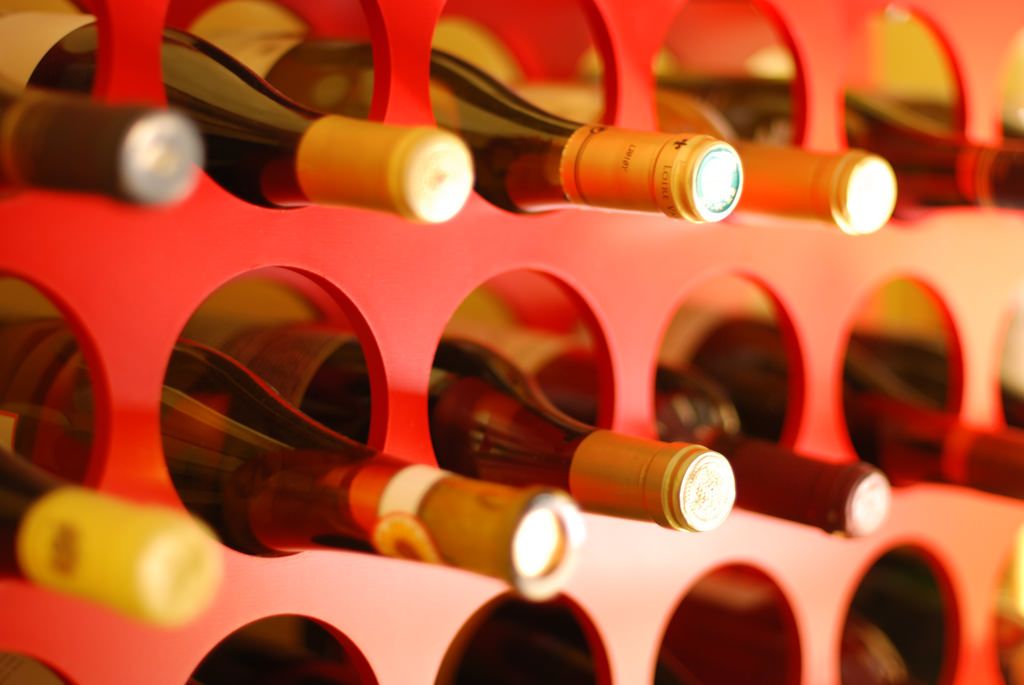
Wine bottles rested on their sides, allowing the corks to remain wet. Image: Flickr / Joe Shlabotnik
When a bottle of wine is stored on its side, the wine will be in constant contact with the cork, which will prevent it from drying out. Why is this important? Because a dry cork will shrink and will not only allow the wine to oxidize, but may even allow wine to seep out, which almost guarantees serious degradation of flavor. The exception to this rule would be if you're using screw caps or glass/plastic corks to stop up your wine. These types of corks/caps obviously won't be susceptible to shrinkage, and therefore the bottles using them can be stored on their sides without any issue.KEEP THE WINES AT A CONSTANT TEMPERATURE
Along with light, temperature is one of the most critical factors in making sure your wines stay drinkable for as long as possible. In general, the best temperature for storing most wines is around 53-55°F. Storing your wine at temperatures colder or warmer than this will — you guessed it — damage a wine's flavor profile, possibly to the point of making it undrinkable.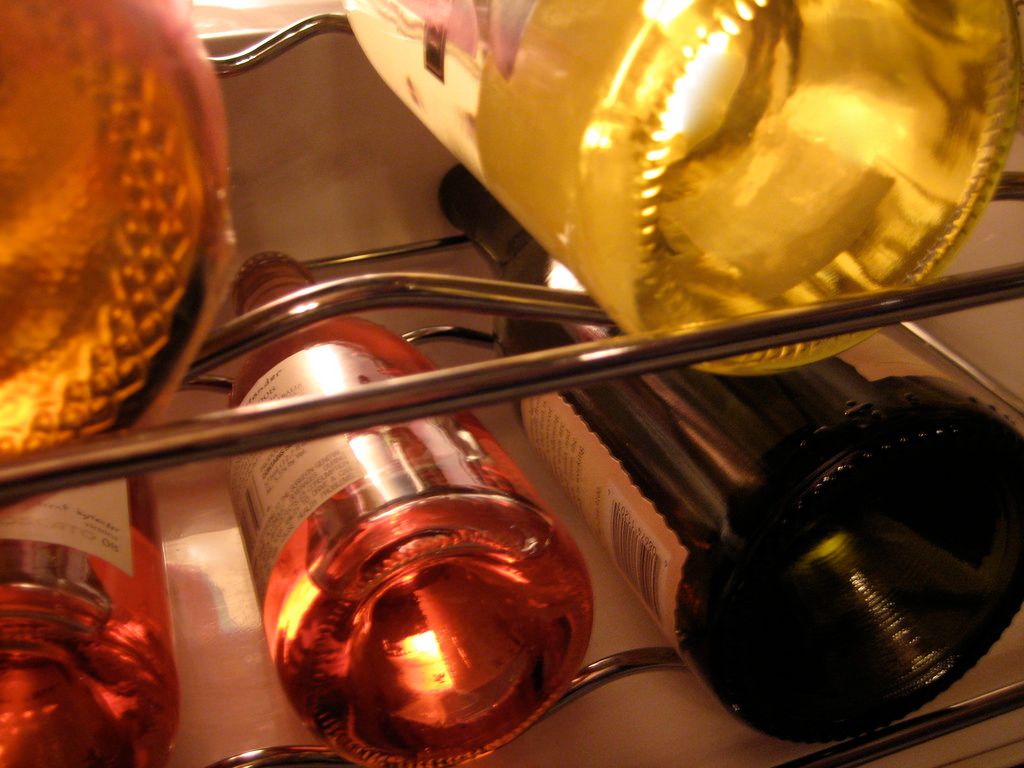
A peek into a wine refrigerator. Image: Flickr / gosheshe
Keep in mind that this temperature guideline is very general, and will vary based on the individual bottle of wine — different styles of wine age at different rates at the same temperature, so you'll want to keep that in mind; it's probably best to ask whoever you're buying the wine from what the best storage temperature is for the specific type you're bringing home. Also keep in mind that these guidelines are for unopened bottles of wine. One of the worst things you can do is store your wine in a place that has constant, significant fluctuations in temperature. While a degree or two is nothing to worry about, five, ten or 15 degrees will seriously damage your wine. Ideally you'd store your wine in a chilled fridge that's kept at a constant temperature, but it's understandable if you don't have the disposable income for that kind of setup. Just keep the temperature cool (in the degree range mentioned above) and constant.KEEP THE WINE STILL (BAD, BAD VIBRATIONS)
Most wine connoisseurs believe that serious perturbations to wine bottles negatively affect wine profiles. The basic theory is that vibrations damage the wine because they speed up chemical reactions that age the wine. The reason these negative effects of vibration are referred to as a "theory" rather than fact is because there's not much hard science to back up this claim. But just to be safe, don't store your wine on top of a clothes washer, next to a refrigerator, or near anything else that constantly vibrates.STABILIZE THE HUMIDITY
Along with stable temperatures, you'll also want to store your wine in a spot that has stable levels of humidity. Too much humidity can lead to mold growth in your bottles, too little can cause those pesky dried-out corks that lead to oxidation. Keeping the humidity at proper levels in your wine storage area can be quite difficult, especially if you don't have a wine fridge, but there are little things you can do to help prevent problematic swings. For example, you can use a humidstat (a device analogous to a thermostat that responds to humidity rather than temperature) to keep track of humidity levels, and then use a humidifier and/or dehumidifier to keep levels where they need to be. Again, ideally you'd buy a wine fridge.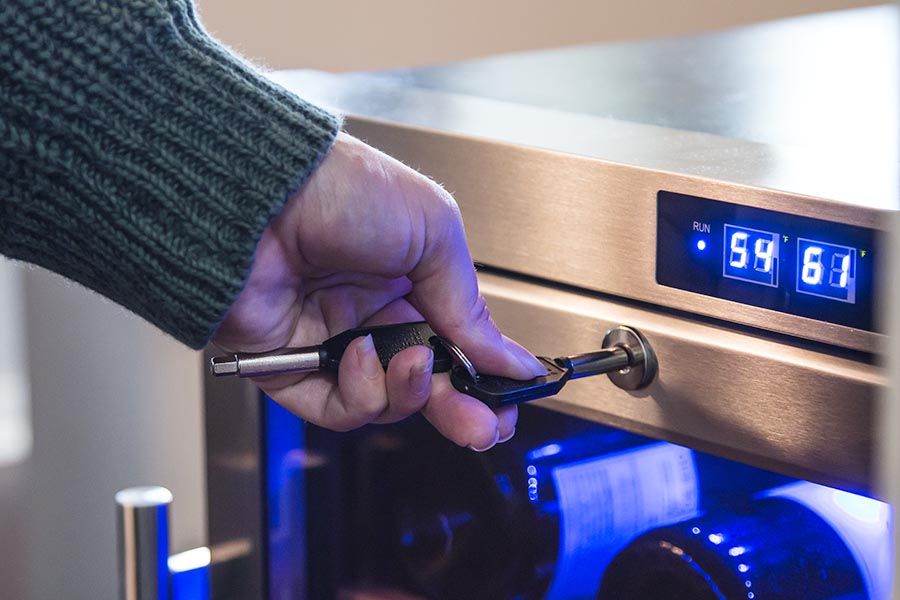
A wine fridge that helps to keep humidity stable. Image: Flickr / Your Best Digs
STORE THE WINE FOR THE RIGHT AMOUNT OF TIME
Although it's reasonable to think that all unopened bottles of wine get better with age, that, unfortunately, is not the case. Young, cheaper wines almost never taste better with age — and can often times taste worse — which means you should drink 'em bottles as soon as possible; this is especially true if you can't store them properly. So don't wait for the perfect occasion to open a bottle of cheap wine, just gather some friends and pop that bad boy open. More expensive wines, on the other hand, often will improve with age, and can be aged anywhere from two to ten years.HOW TO STORE OPENED BOTTLES
Finally, when it comes to storing opened bottles of wine, you'll actually want to bust out with your normal fridge for best results. The low temperature of a normal refrigerator will slow down the imminent oxidation process that'll occur thanks to air getting in from any opening between the cork and the neck of the bottle. Despite the fridge's ability to keep oxidation at bay, you'll still want to make sure any opened wines are properly sealed, and positioned on their sides. You also shouldn't leave an opened wine bottle in the fridge for more than three to five days; after that, you're again looking at serious degradation to the wine's flavor profile.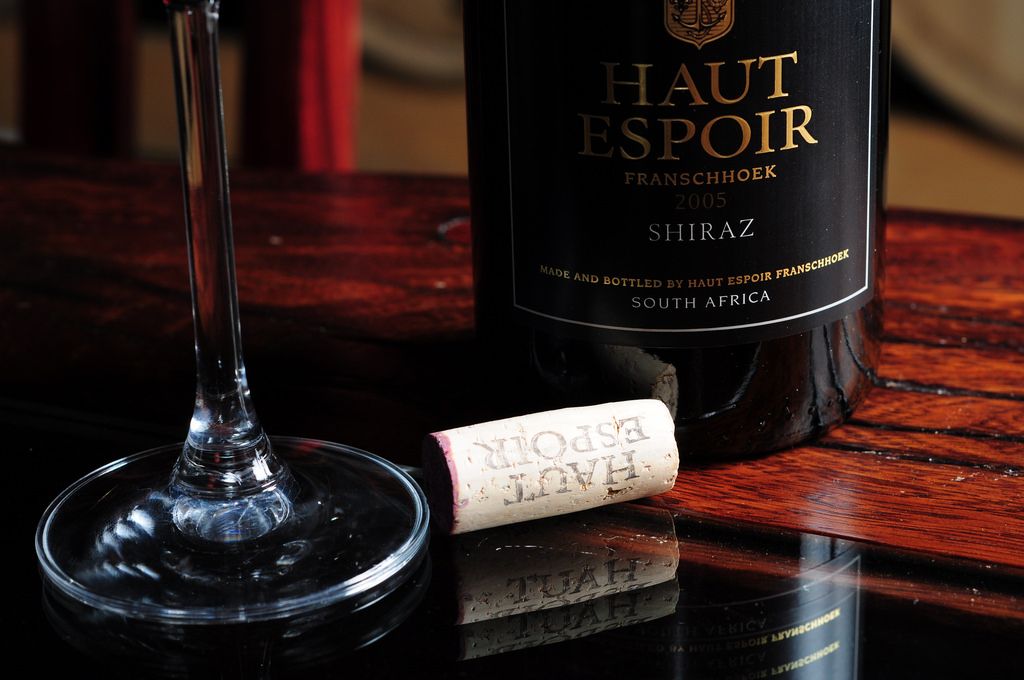
An opened bottle of wine and its cork. Image: Flickr / Paul Scott
THE FUTURE OF WINE
The final section, people! Here it is: the future of wine. And really, nothing about wine is going to change in the future. Oh no, wait — EVERYTHING is going to change for wine in the future. Well, almost everything. Millennials are going to change the way wine's bought, climate change is going to change the way wine is produced, drones are going to change the way wine is delivered, and QR codes are going to change the way wine bottles are labeled. Oh, and speaking of wine bottles, a bunch of them may soon be made of sugar. With all of those crazy developments in mind, let's learn about the future of wine!HOW MILLENNIALS WILL CHANGE THE WINE GAME
First up, we need to discuss the way Millennials are going to change the wine game, 'cause while they may not be stuffing avocado toast into random bottles of Sauvignon blanc, they will be changing the way wine is marketed and sold. Over the next decade or so Millennials are going to start out-buying Baby Boomers when it comes to wine, and they're not going to do it in the same way as their older (probably wealthier) counterparts. In fact, various reports from researchers show that rather than trusting their own palates and experiences with wine, Millennials will be more focused on what's trending in the wine world. According to the folks who have a big stake in the future of wine, Millennials will be less focused on scoring systems that have traditionally been used to rank wines, and more focused on what they're peers are drinking at the moment. This makes sense considering the fact that Millennials are so hyper-connected with each other thanks to the internet. https://giphy.com/embed/xUOxfoeSN9GZt2EJfG Speaking of the internet, Millennials are going to keep up with each other and general trends on social media sites more than any other type of network. Researchers are saying that wine producers are going to have to have a significant presence in the social media world in order to get Millennials' attention, which means they'll have to boil their messages down to 240 characters or at the very least, a spiffy Facebook post or Pinterest ad. But wine producers won't only need to adapt to social media marketing, they'll also need to "tell a story" about their wines. Apparently Millennials will be looking for wines that have a narrative background because that'll make them more shareable on social media. (These Millennials seem obsessed with everything except for the wine in the bottle, right?) Finally, Millennials will be looking for wines that don't only tell a good story, but are also healthy and environmentally friendly. Oh, and cheap; Millennials are going to want more and more cheap wine. Maybe because of all that avocado toast, right?!CLIMATE CHANGE AFFECTING WINE PRODUCTION
Why are those dang Millennials so obsessed with choosing winemakers who are environmentally friendly? Oh right, because of potential climate catastrophe taking place over the next century. And while climate change will most definitely change the wines that Millennials will buy, it'll also change the way the wine is produced. Seriously, winemakers are going to have to scramble hard to deal with climate change. https://giphy.com/embed/xW0jLM0inO51e Over the next 50-100 years, global temperatures are going to rise (something on the order of .74 degrees Celsius over 100 years) and that'll undoubtedly have significant effects on viticulture in countries across the world. Wild temperature swings are going to happen in both directions though, depending on the region, and both extreme highs and lows will negatively affect wine grape vineyards. Terroirs that rely on rainfall will dry out, grapevines exposed to extreme heat will produce grapes that have lower tannin and anythocyanin levels, and vineyards exposed to unusually long frosts will yield less and less usable grapes. Increased ultraviolet light and CO2 levels will also have huge impacts on wine production — increased CO2 levels, for example, will decrease the swings in temperature from day to night in some terroirs, causing negative changes to the wine grapes' aromas, flavors, and phenolic content.INCREASE IN OFFERING ORGANIC, BIODYNAMIC WINES
Millennials won't only be buying wines that are gentler on the environment, they'll also be looking for wines that are gentler on their soft, little Millennial bodies. What does this mean exactly? It means you'll be seeing a lot more "organic" and "biodynamic" wines on shelves. You're probably wondering how in the world wine can get any more organic, but surprisingly, there's a lot that can be changed in order to make wine production more "natural." Basically, when it comes to making organic wines, it's all about what's not used to make them. As of right now, many winemakers, especially large-scale ones, use added sulfites (organic compounds) to maintain a wine's freshness and also decrease the effects of oxidation. Unfortunately, while sulfites can be used for this purpose, they can have negative effects on people's health. Well, some people, as they can literally have a sulfite intolerance — not exactly an allergy to sulfite, but it will cause them to feel ill. Winemaking can also become more organic by skipping out on the pesticides and fungicides, which can negatively affect both people's health and the environment.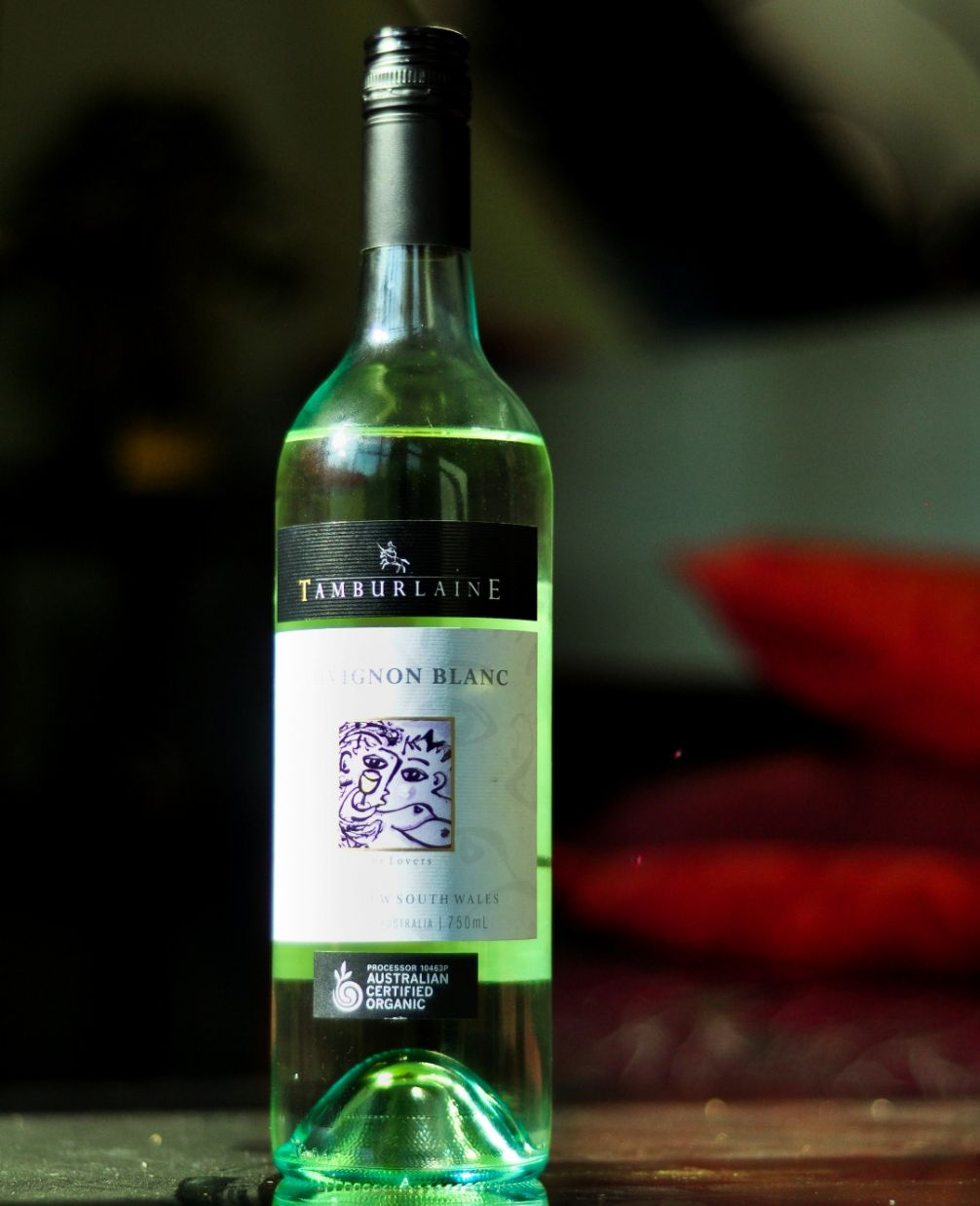
A bottle of organic wine. Image: Wikimedia / Kathmandufoodies
Along with organic wines, "biodynamic wines" are also expected to become a lot more popular in the future. What is a biodynamic wine, you ask? It's somewhat hard to say — while there are definitely winemakers who make wines in a biodynamic way, everybody agrees that the biodynamic method doesn't have any effect on taste. Not only that, but unlike the "organic" moniker, the biodynamic label doesn't necessarily mean that any particular chemicals have been avoided; the same guidelines that qualify a wine as organic are often followed though.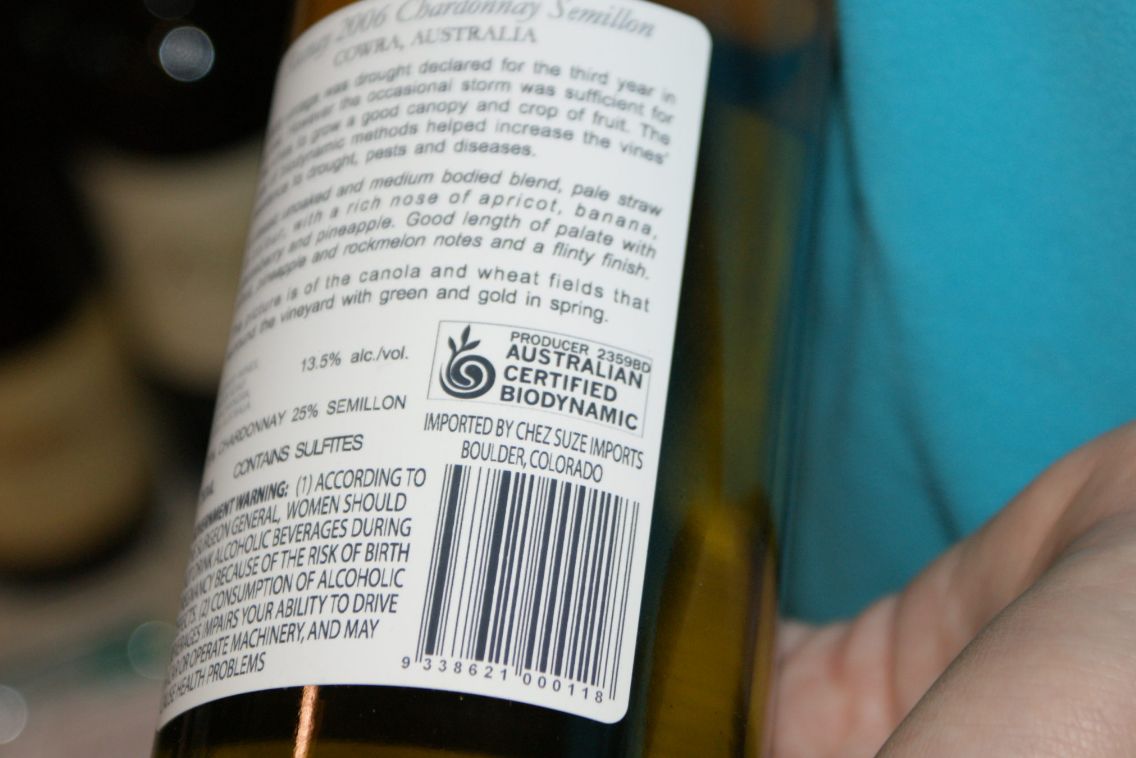
A certified biodynamic wine from Australia. Image: Wikimedia / deegee@fermentarium.com
Ultimately, all biodynamic really seems to mean is that the wine was made in a way that's pleasing to the universe and in balance with nature. And no, we are not kidding. Makers of biodynamic wines take into account things like the lunar cycle and astrology to help determine the best time for harvesting their grapes. They also have phases of growth that they follow, which themselves are reflections of the elements, earth, wind, fire, and water. So yeah, be prepared for biodynamic wines to hit the shelves en masse. Wait, actually they'll taste the same as normal wines, so you won't need to be prepared for them; instead, prepare yourself for biodynamic Millennials.CHANGES IN WINE TECHNOLOGY
Finally, on top of all the other changes noted above, we have changes to wine technology: how it's bought, how it's bottled, how it's sold, how it's delivered, how it's marketed, that's all going to change significantly over the next few years. And while there are certainly tons and tons of technological changes to be expected in all wine-related areas, we've boiled down what we think will be the biggest (or at the very least the craziest) changes that will be coming up in the future. First up, if you're used to driving or walking to the local liquor store to grab your precious vino, be prepared to put down your keys and take off your sneakers forever. OK, that's an exaggeration, but at least you probably won't need those things to get a few bottles of wine in the near future. Why? Because, drones, that's why. Seriously though, industry experts are predicting that "instant delivery" via drone will soon become the new normal for getting wine from liquor stores — or more likely, Amazon warehouses — into people's homes. The specifics of how this kind of delivery will go down are still unclear, but it's not hard to imagine a quadcopter drone carrying a bottle of wine above city streets, only to finally arrive at your doorstep where it drops off a nice bottle of Cabernet sauvignon or Riesling. Aside from being super convenient, this new delivery method may help people to avoid drinking and driving, which is always a plus.
A prototype Amazon Prime Air delivery drone. Image: Flickr / William Warby
Along with drone delivery, wine aficionados should also expect an evolution in wine labels with the addition of QR codes as well as options for viewing a wine bottle's information with the aid of augmented reality. And while in many cases the mention of augmented reality and/or barcodes that give away way too much information brings up visions of a Minority Report-ish world, chances are that when it comes to wine, this stuff will just be plain fun. Imagine not just reading about the varietal in your hand, but taking a tour of the vineyard where it was grown right there in the middle of the supermarket booze aisle. Exciting stuff, right? If drones, QR codes, and augmented reality don't float your vino-tech boat, maybe wine vending machines and wine bottles literally made out of sugar will. Because there are doubtlessly some true geniuses in the world of wine, researchers expect that wine vending machines using iris recognition technology will, at some point, become ubiquitous. Not only that, they'll has keep track of your personal wine references — and probably your social security number and credit score too! (OK, that's a joke, but we wouldn't be surprised, y'know?)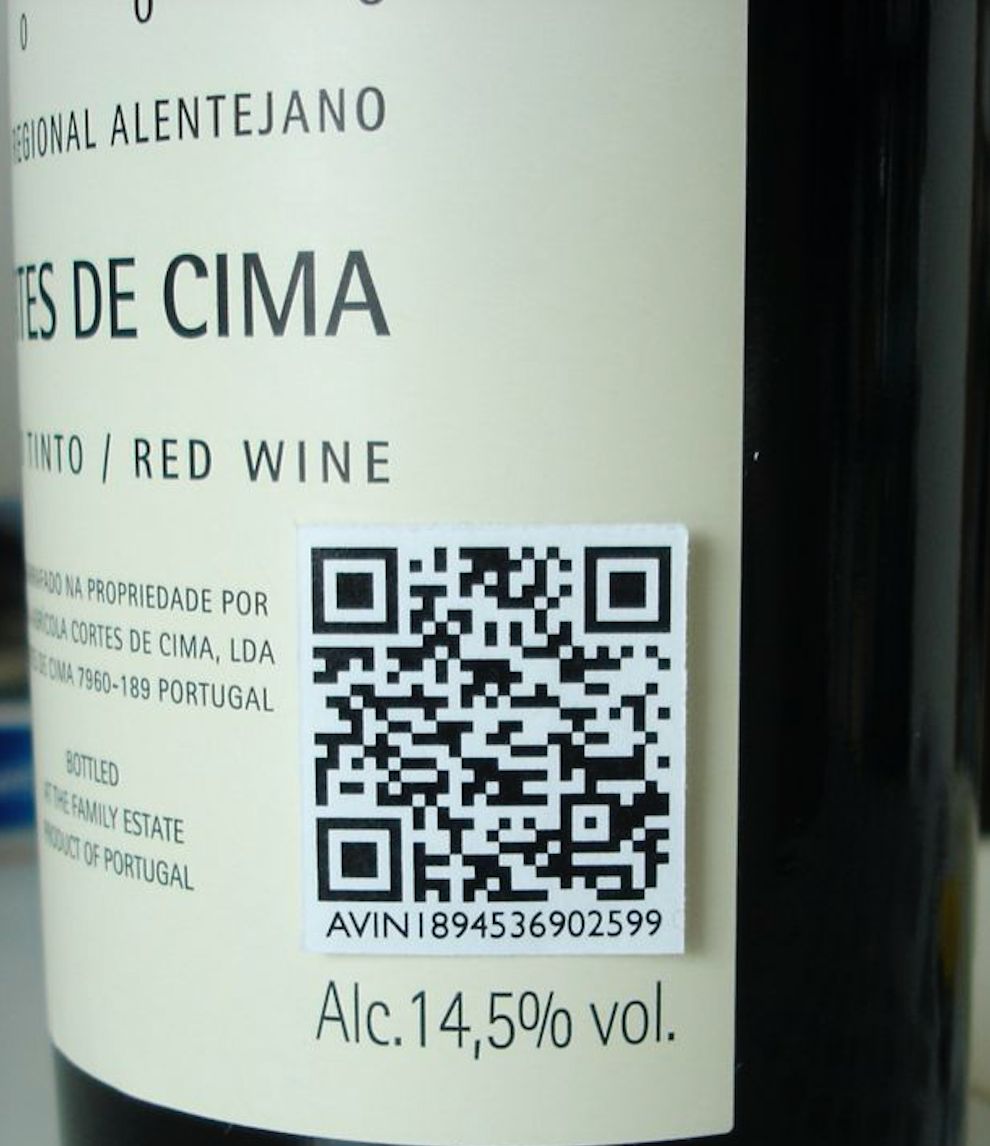
A QR code on a wine bottle. Image: Flickr / adegga
In regards to the sugar bottles, there's apparently a trend toward making both wine bottles and even wine glasses edible. People working on this technology say that it's the way of the future because edible glasses and bottles will be super environmentally friendly, as well as, well, edible. Out of everything mentioned in this Future of Wine section, somehow this stands out as the most outlandish potential development, which just goes to show you that we really are living in the first quarter of the 21st century — a time when everything is changing just a like a fine wine over time. Or maybe a not-so-fine one depending on how angry those delivery drones get once they're sentient.TEN OF OUR FAVORITE WINE COCKTAILS
Here are ten awesome wine cocktail recipes you can make for parties, hangouts with friends, or just for yourself after a long week! 2. RED WINE POPSICLE SANGRIA
2. RED WINE POPSICLE SANGRIA
 3. RED WINE HOT CHOCOLATE
3. RED WINE HOT CHOCOLATE
 4. STRAWBERRY FROSÉ
4. STRAWBERRY FROSÉ
 5. TEQUILA SANGRIA
5. TEQUILA SANGRIA
 6. WINE SLUSH
6. WINE SLUSH
 7. BLUE LAGOON SANGRIA
7. BLUE LAGOON SANGRIA
 8. DIY ROSÉ GUMMY BEARS
8. DIY ROSÉ GUMMY BEARS
 9. BIG BEAR SOUR
9. BIG BEAR SOUR
 10. LETTERS TO PARIS
10. LETTERS TO PARIS

GIFS: Giphy

Independence Day Drinks
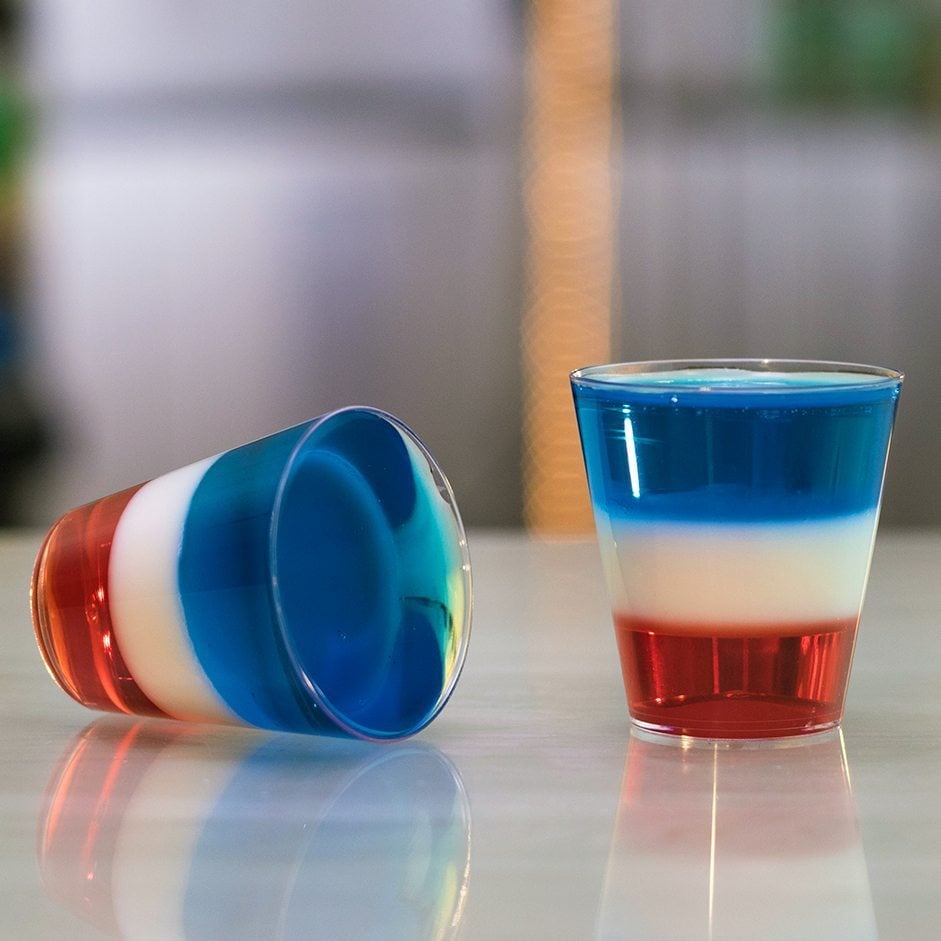
4th Of July All American Jello Shots

4th Of July Cake Vodka Milkshake

4th Of July Diversity Bomb Shot
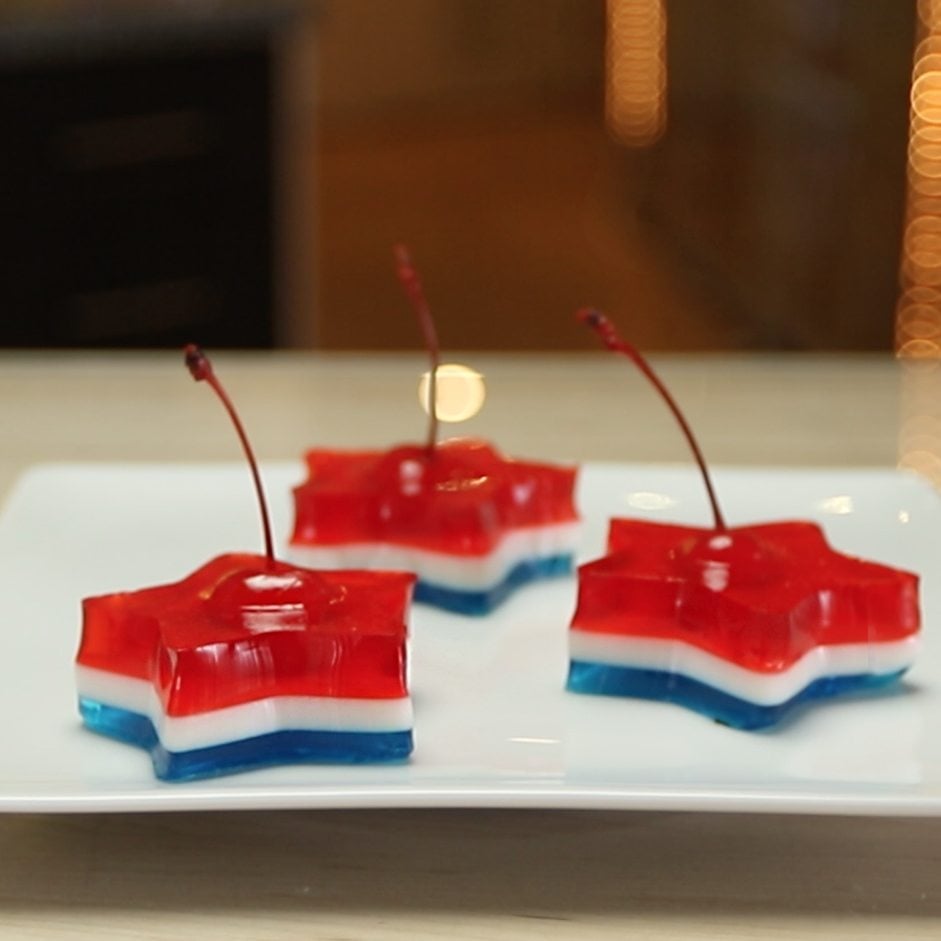
4th Of July Jello Shots
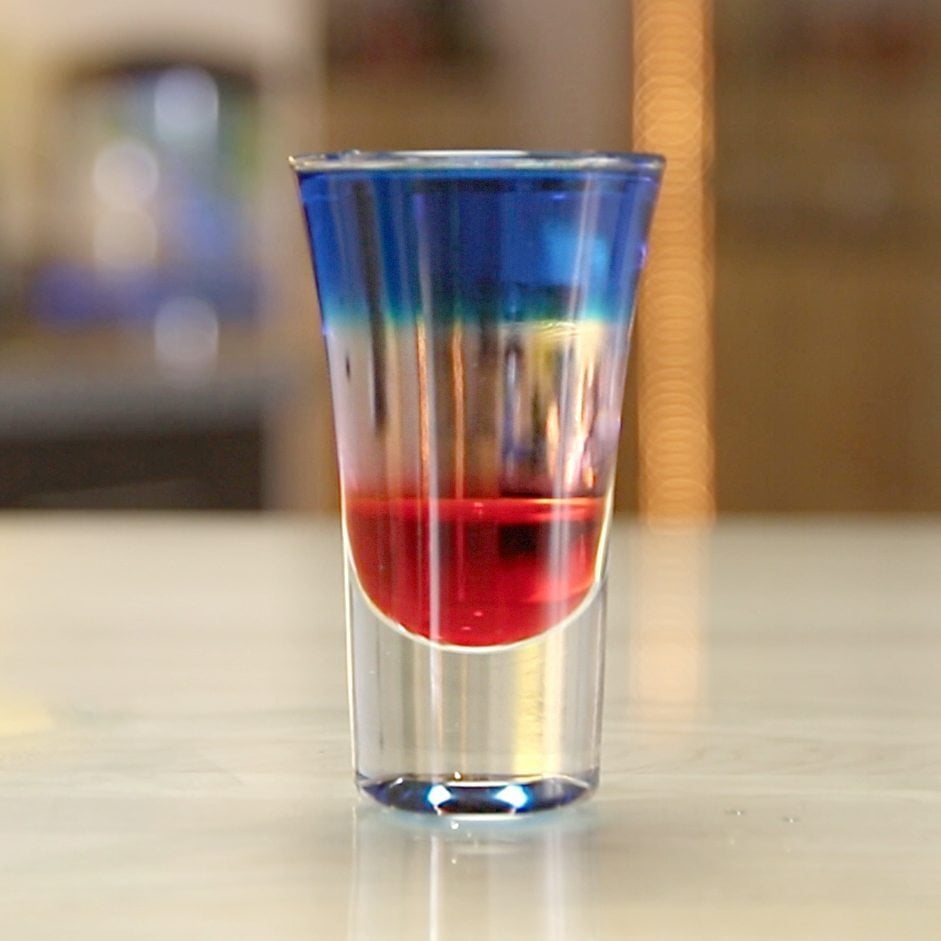
4th Of July Layered Shots
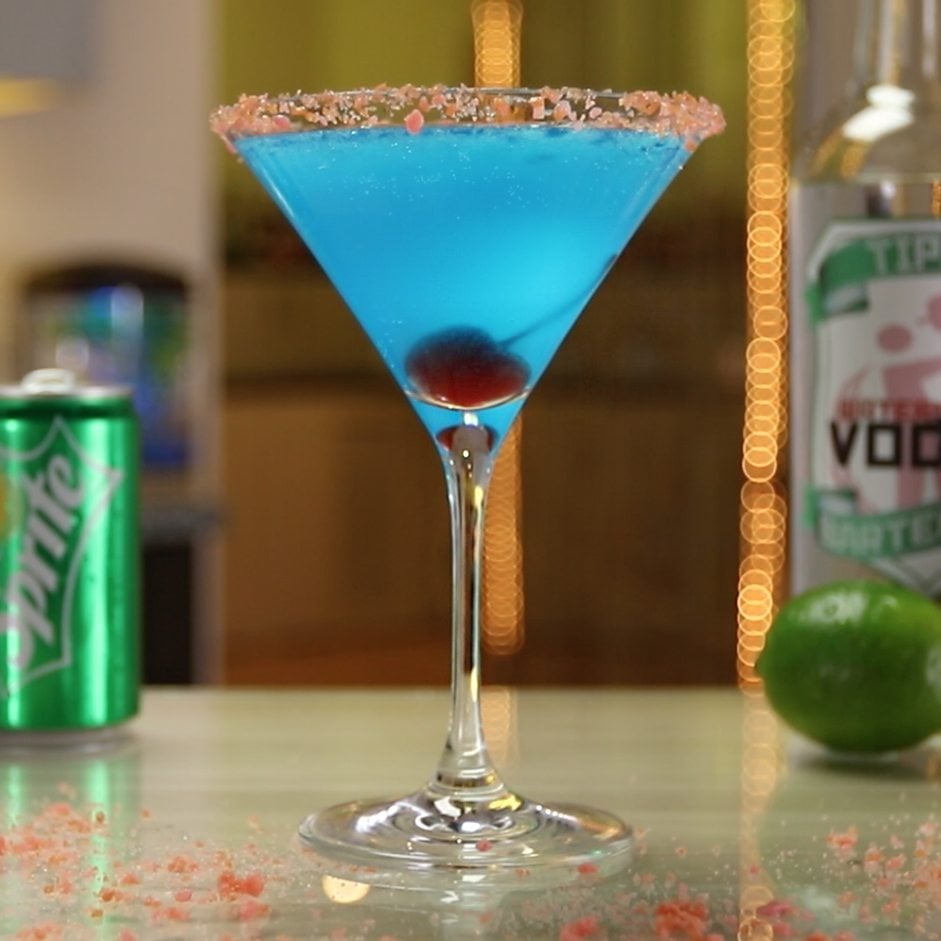
4th Of July Pop Rocks Martini
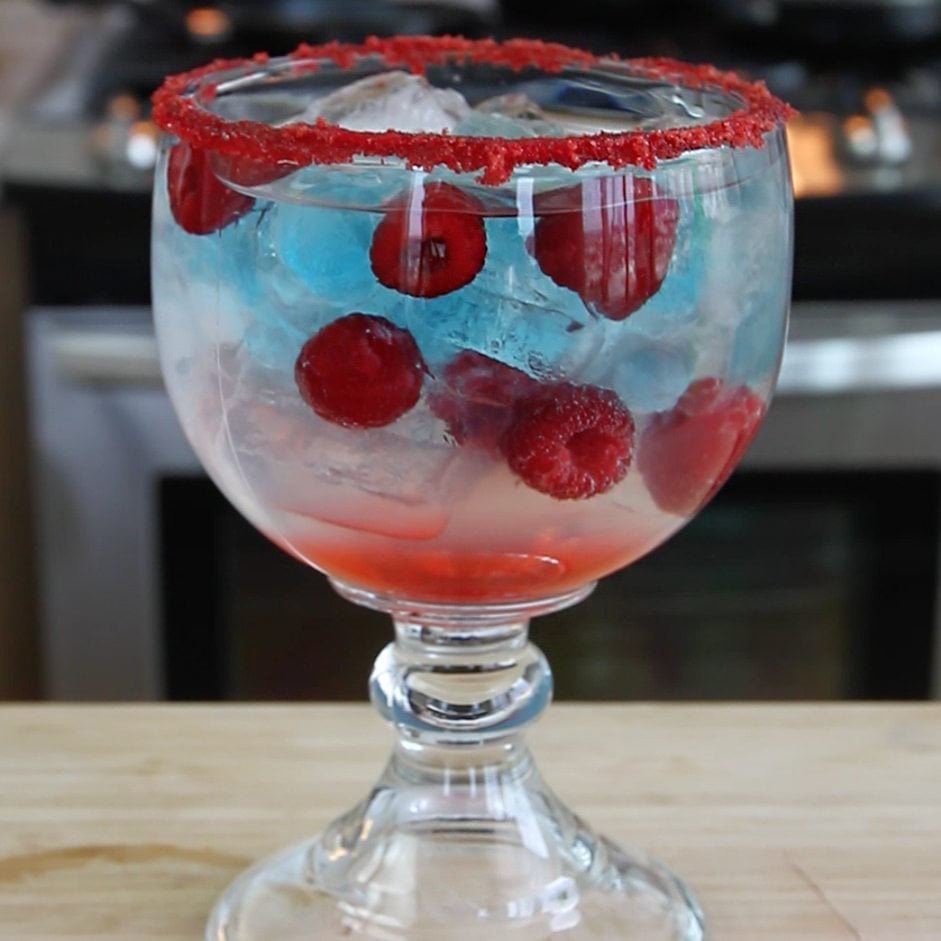
4th Of July Raspberry America
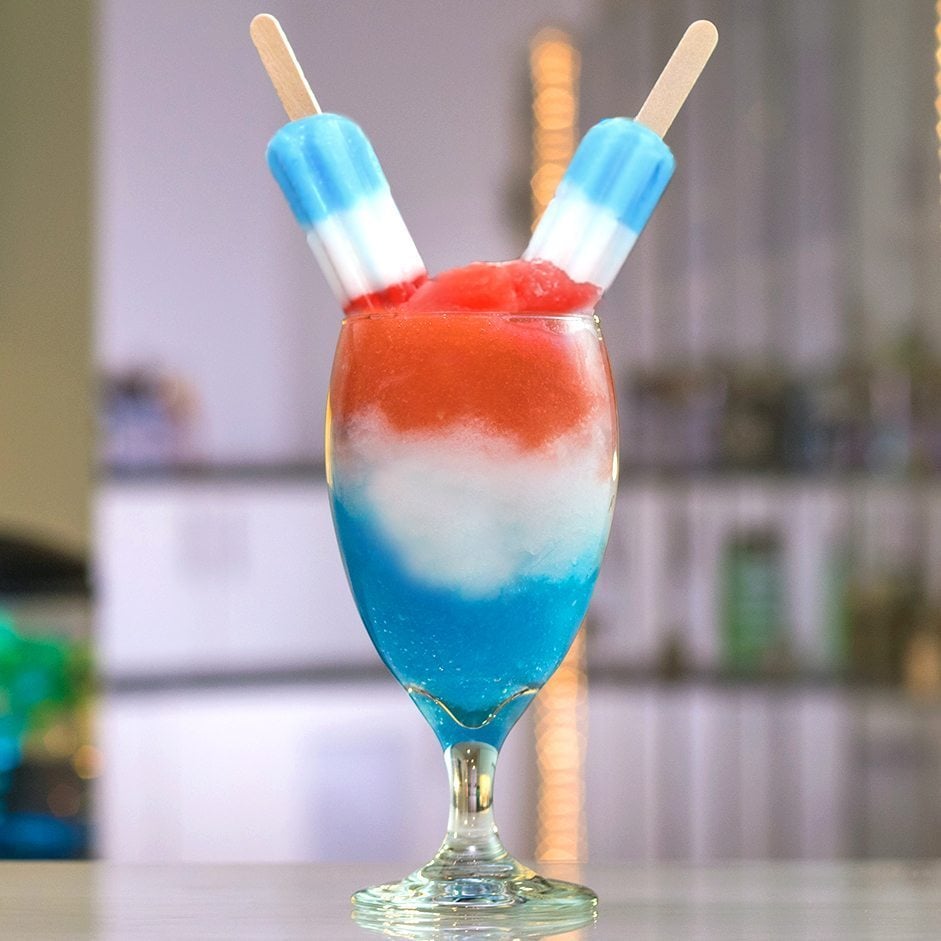
4th Of July Spiked Bomb Pops
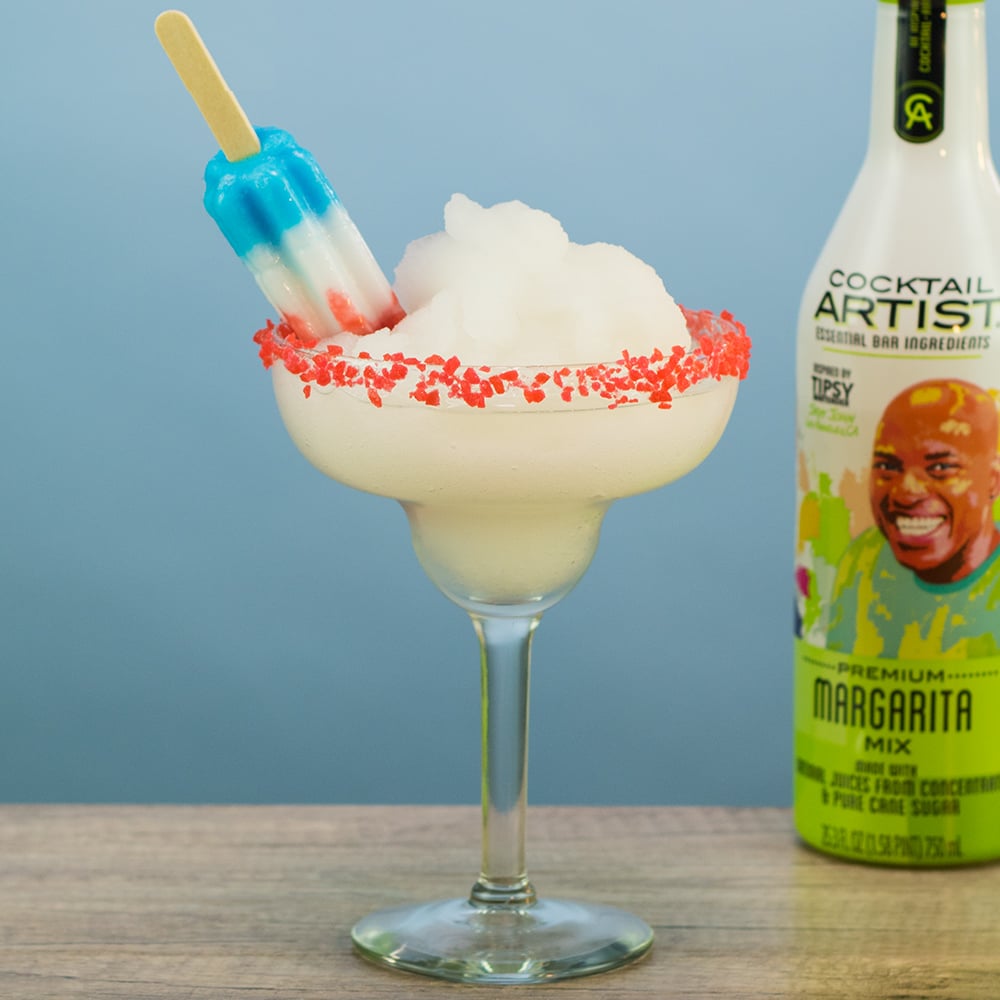
4th July Popsicle Margarita
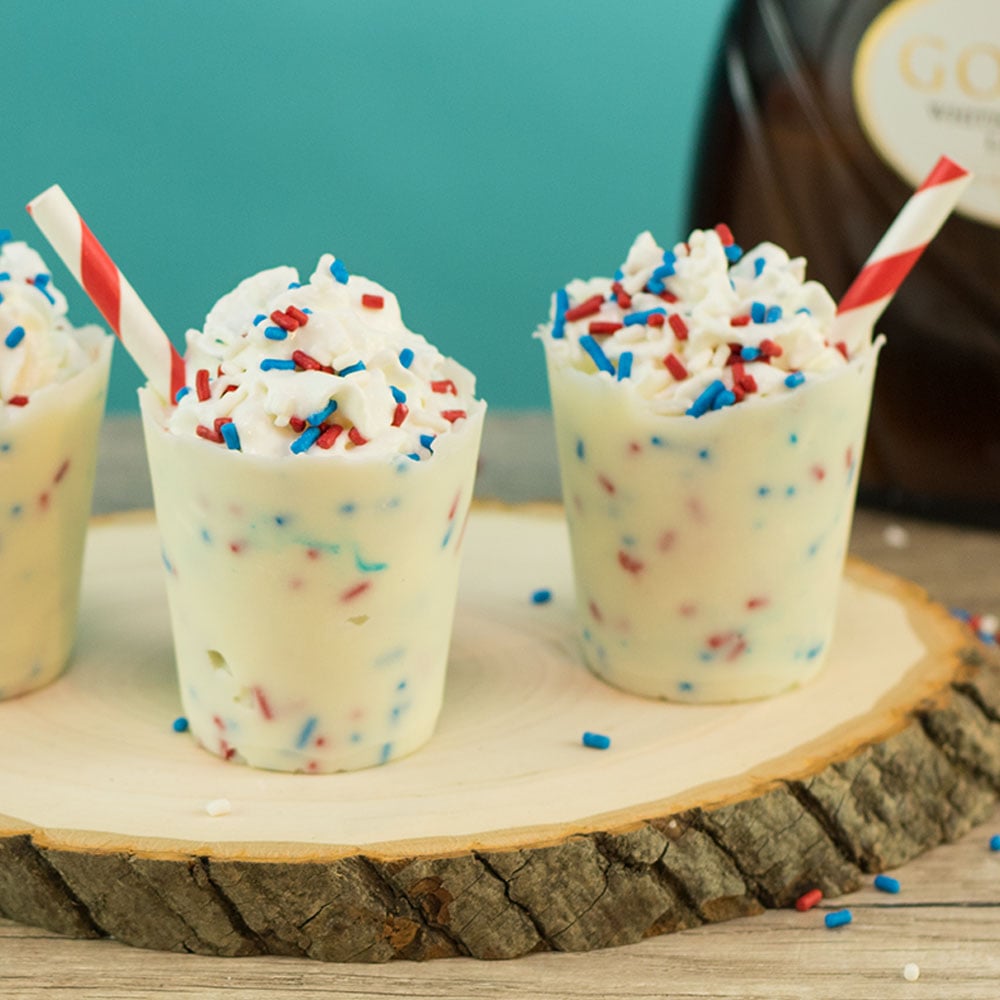
4th July Edible Shot Glasses
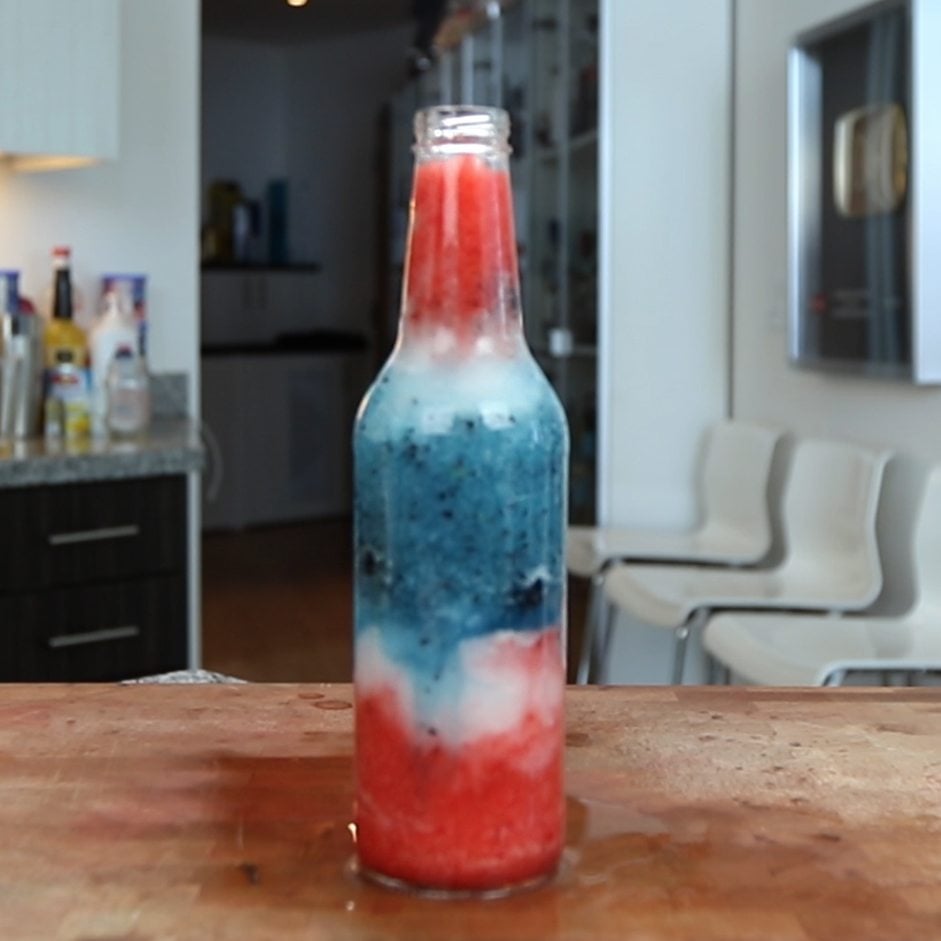
4th July In A Bottle
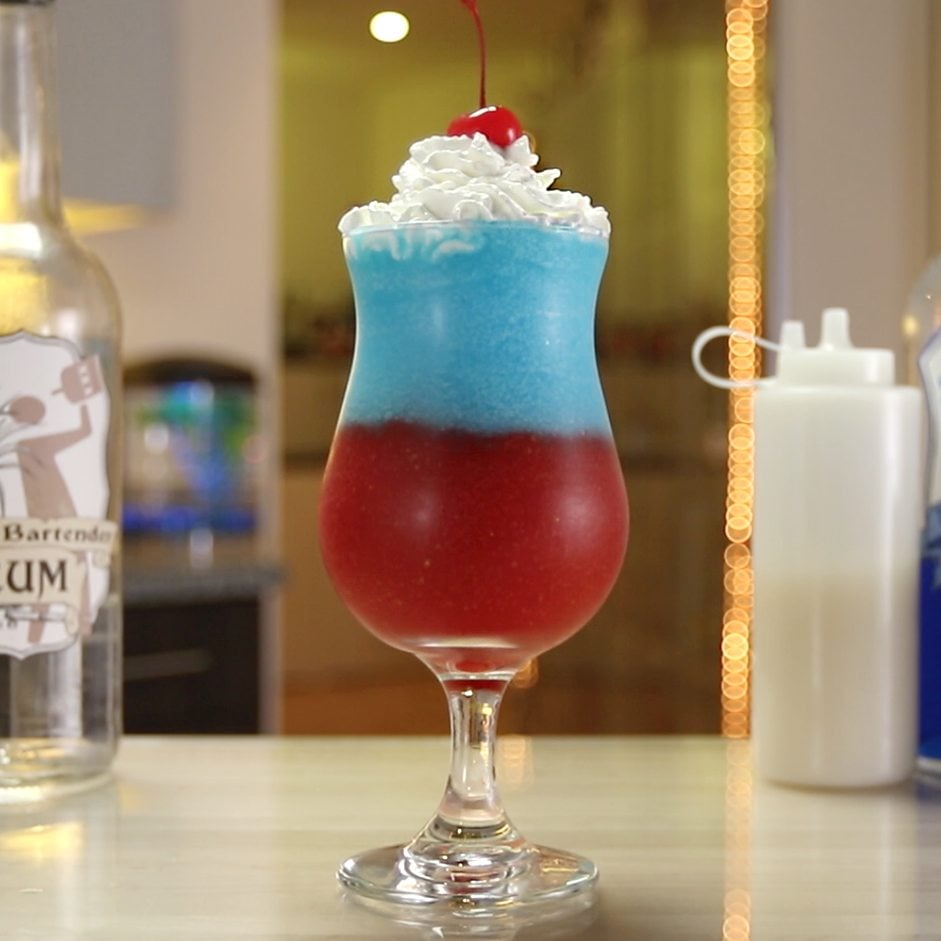
All American Daiquiri













